The Economic and Social Implications of Mass Tourism in Rome

- Italy , Rome , Travel
- June 15, 2023

Too Many Tourists In Rome?
Mass tourism in Rome is nothing short of a blight on it’s beauty, culture and vibe. On one hand, it generates revenue and creates jobs in the hospitality and retail industries, but on the other, it leaves a trail of destruction in its wake. The city’s infrastructure is stretched to breaking point, and its cultural heritage is being erased. This is the grim reality of the economic and social implications of mass tourism in Rome. So, travel like a local … when in Rome do as the Romans do, this is the best things to do in Rome .
The Economic Side Of Things
Let’s start with the economics of the situation. Yes, it’s true, tourism has created jobs and brought in revenue. However, it’s also true that small business owners are struggling to compete with multinational corporations who have taken over much of the city’s tourist hotspots. As a result, small businesses are closing, and low-wage workers are losing their jobs. This is the price of progress, I suppose, but it’s not progress worth celebrating.
And what of the high cost of living? The large number of visitors to Rome has driven up the cost of housing, food, and other necessities, making it difficult for local residents to afford to live in their own city. This is a bitter pill to swallow, and it’s not surprising that some residents feel resentful. They see their city being taken over by tourists, and their quality of life deteriorating as a result.
The Social & Cultural Side Of Things
Now, let’s turn to the social and cultural implications of mass tourism in Rome. The city’s infrastructure is at breaking point, with overcrowding, traffic congestion, and air pollution becoming increasingly commonplace. This is the price of having too many people in one place, and it’s not a price worth paying.
Furthermore, the influx of tourists has disrupted the local culture, transforming traditional neighborhoods and historic sites into tourist hotspots. This is cultural vandalism on a grand scale, and it’s a tragedy that the unique character and heritage of Rome is being erased in this way. The loss of the city’s unique character and cultural heritage has a negative impact on the sense of community and has created a sense of resentment among residents.
Gentrification is another social issue associated with mass tourism in Rome. The rapid influx of tourists and the demand for high-end hotels, restaurants, and shops have led to the redevelopment of many traditional neighborhoods. This has displaced many long-time residents, altering the character of the city, and creating a sense of resentment.
What About The Locals? What Do Romans Think?
Finally, mass tourism has led to a decline in the quality of life for local residents. The large number of visitors has resulted in overcrowding, noise pollution, and other environmental problems. In addition, the influx of tourists has made it difficult for residents to access certain services, such as healthcare and public transportation, which are often overwhelmed by demand.
To Wrap It All Up – Do As The Romans Do?
In conclusion, mass tourism in Rome is a double-edged sword. On one hand, it generates revenue and creates jobs, but on the other, it leaves a trail of destruction in its wake. The high cost of living, gentrification of historic neighborhoods, and strain on the city’s infrastructure are just some of the negative impacts of mass tourism. It’s time for the city to develop a more sustainable tourism strategy that balances the needs of tourists and local residents. This could include limiting the number of visitors, promoting responsible tourism practices, and investing in infrastructure to support sustainable growth.
But let’s not hold our breath; after all, greed and thoughtless exploitation often win out over common sense and responsibility.

Best Things to do in Paris Things to do for couples in Berlin Best Things to do in Rome Activities in Barcelona
Top Podcasts
Bill Browder Nathan Lynch Mikael Syding Martin Schibbye
About Atlas Geographica
About Contact Subscribe to our newsletter Patreon
© 2023 Atlas Geographica. All rights reserved
'Curious Worldview Newsletter'
Before you continue… did you know Tim Ferriss values his email newsletter higher than his podcast?
I want to create the same relationship with you.
Join 10,000+ fellow comrades and friends…
Sign Up & Leave Your Email Here…
- Italy's news in English since 1985
- Where to buy your copy of Wanted in Rome
- Magazine issues
- Work with us
- Privacy Policy
- Insert your Classified
- How to insert your Classifieds
- Jobs vacant
- Jobs wanted
- Accommodation vacant in town
- Accommodation vacant out of town
- Property for sale in town
- Property for sale out of town
- Rooms and flat shares
- Holiday Accommodation
- Accommodation wanted
- Insert your Yellow Page
- About our Yellow Pages
- 29 Best Things To Do in Rome
- Visiting the Vatican Museums: All You Need to Know
- What and where to shop in Rome
- Advertise with Us
Wanted in Rome Magazine
Latest news
- Classifieds
- Yellow Pages
- Images of the day
- Video of the day
- Ukraine crisis: Italy
- Coronavirus in Italy
Urban areas
- Pigneto neighbourhood
- St Peter's Area
- Trastevere neighbourhood
- Campo de' Fiori neighbourhood
- Flaminio neighborhood
- Historic centre area
- Colosseum, Monti
- EU’s General Data Protection Regulation (GDPR)
Impressionism exhibition in Rome: The dawn of modernity
Rome hosts World Press Photo Exhibition 2024
Ouka Leele exhibition in Rome
Lord Byron: Rome poetry reading by Poet Laureate Simon Armitage
Rome theatre in English: We Care by Shane Harnett

Italy's Battle with Problem Tourists
Italy wants its foreign tourists back but not at the expense of damage to its precious cultural heritage..
This summer's international headlines about tourists damaging Italy's sites and monuments weren't supposed to be like this. Just a few months ago there was much talk of rebuilding the country's tourist industry, devastated by a 10-week lockdown in the spring and the travel restrictions imposed by the covid-19 pandemic.
The relaunch was seen by the more optimistic in the sector as a golden opportunity to break away from the broken model of mass tourism, moving on from the bad old days of unruly visitors jumping in fountains and treating Italy's heritage with complacency or even downright disrespect.
There were grand plans of replacing selfie tourism with slow tourism, aimed at the more discerning visitor, who clutched a guide-book rather than a selfie stick.
- The Colosseum looks to a post covid-19 era
Alfonsina Russo is the director of Parco Colosseo, the archaeological park incorporating the Colosseum, Roman Forum and Domus Aurea, which attracted 7.5 million tourists last year. In a May interview with Wanted in Rome , Russo was frank about a situation that she believes must change for the better, saying she hoped the “new tourists” would visit out a “need for nourishment” from the priceless heritage she oversees.
In the past “it was clear that it was mostly a selfie tourism” – Russo said – “tied to tours of less than two hours, interested in the photo shoot sometimes without the awareness and the memory of that shot.”
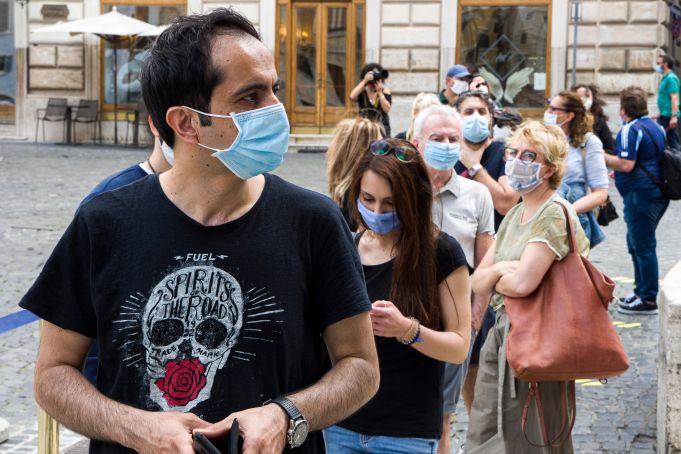
Queuing at the Pantheon. Photo credit: Mastrullo / Shutterstock.com.
Russo's views were reflected by Eike Schmidt, the director of the Uffizi Gallery, who called for people to drop the “bucket list” approach in favour of savouring the moment through a “slow tourism” model. Florence mayor Dario Nardella echoed Schmidt by saying: "We want to use culture to send a message that after this crisis we want to change lifestyle models, the economy and model of tourism of the city."
- UN chooses Italy to restart global tourism
This optimism was enhanced in late June when Italy was chosen by the United Nations World Tourism Organization (UNWTO) as the launch pad for the global Restart Tourism drive after the coronavirus lockdowns around the world, with Italy hailed as a "world tourism leader."
With lockdown in March, Italy's tourist numbers plummeted overnight, leaving normally crowded Italian cities virtually deserted for months. This was most evident in Venice where up until last year residents complained that the streets and canals were thronged with too many people, before suddenly bemoaning their absence from the spring onwards.
- Venice activists cheer as cruise ships steer clear of canal city
The unexpected situation saw Venice scrap its controversial tourist tax which was scheduled to come into effect on 1 July. In recent weeks the much-maligned giant cruise ships decided to steer clear of the city's lagoon, opting for the larger Italian ports of Genoa and Trieste instead.
This news was welcomed by activists but protested by Venetian gondoliers and restaurateurs who will miss the revenue. The whole affair has served to put Venice's complicated relationship with tourists – and mass tourism – back into the spotlight as never before.
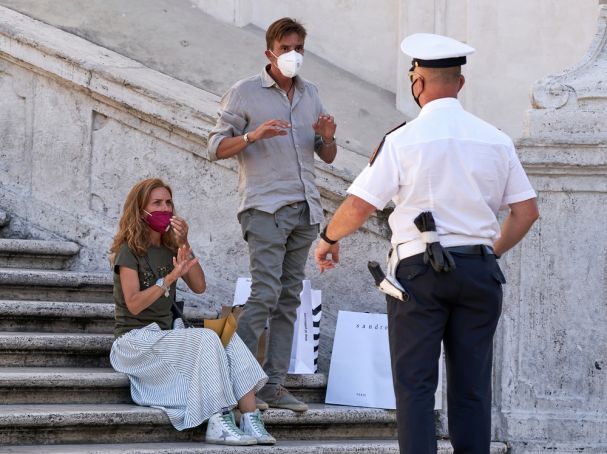
No sitting at the Spanish Steps. Photo credit: Daniele COSSU / Shutterstock.com.
Rome is another city whose bread and butter is the hospitality industry. The capital too has a love-hate relationship with its foreign visitors. In the past the city has been accused of a complacent attitude to tourists, a case of "chewing them up and spitting them out," while Romans are quick to point to incidents of ignorant tourists splashing in historic fountains or, worse, carving their names into the Colosseum.
As foreign visitors return to Italy in small numbers – 70 per cent less than last August according to the Demoskopika research institute – there has been one negative tourist story after another in the media.
- Covid-19: Italy loses 70 per cent of foreign tourists in August
The narrative tends to be the same. Once a tourist commits a crime against Italian heritage – be it accidental or on purpose – Italy’s much-needed visitor suddenly becomes the enemy. These “barbarians” are the subject of vitriolic posts on social media, facing suggestions of draconian punishments from having their hands chopped off to life imprisonment.

Selfies at the Trevi. Photo credit: Alessio Pierdomenico / Shutterstock.com.
The first "bad tourist" story this summer was in Venice in early June, the day after European tourists were allowed to re-enter Italy.
The incident involved two middle-aged men, reportedly German, who swam down the Grand Canal , laughing off pleas from locals to get out, as their partners filmed their antics. The tourists were later apprehended by police as they walked through the city barefoot, dressed in just their wet swimming costumes. Officers fined the men €450 each and ordered them to put some clothes on.
- Tourists fined after climbing into Roman Forum by night
In early August a group of young, and reportedly drunk, British tourists scaled the walls of the Roman Forum by night. The four tourists, aged between 17 and 19, were spotted by security guards who tipped off the carabinieri. The visitors were charged with trespassing and failure to respect a ban on entering the archaeological area, and were fined a total of €1,600 for their escapade.
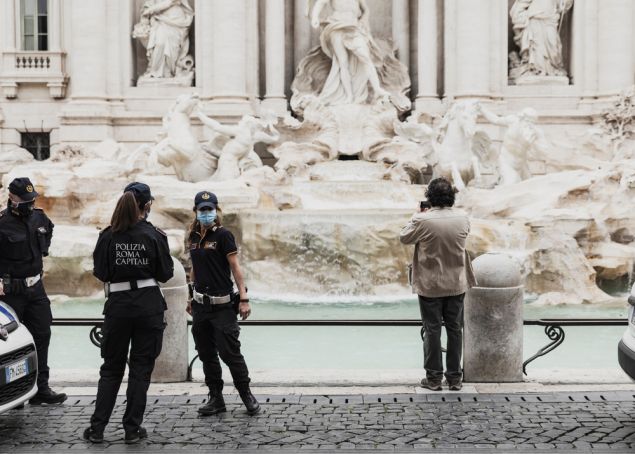
Patrolling the Trevi Fountain. Photo credit: Enrico Tricoli / Shutterstock.com.
However all this was relatively harmless for what happened on 31 July at the Antonio Canova Museum in the northern Veneto region. An Austrian tourist, keen to take a selfie, sat down on Canova's plaster model for the Paolina Borghese masterpiece in Galleria Borghese. After sprawling back on its base, the tourist managed to snap off three of the statue's toes in his effort to stand up. Far from alerting museum authorities, the man made sure that nobody saw what he had done before doing a runner.
- Italy: tourist damages Canova sculpture after sitting on it for selfie
The news was announced by politician and art critic Vittorio Sgarbi, the president of the foundation in charge of the museum in Possagno, Canova's hometown. An outraged Sgarbi called on police to identify the "vandal" and "not let him return to his homeland unpunished" for the "unacceptable" damage caused to the work. For once, Sgarbi's views were shared by the majority, but still no trace of the offending tourist.
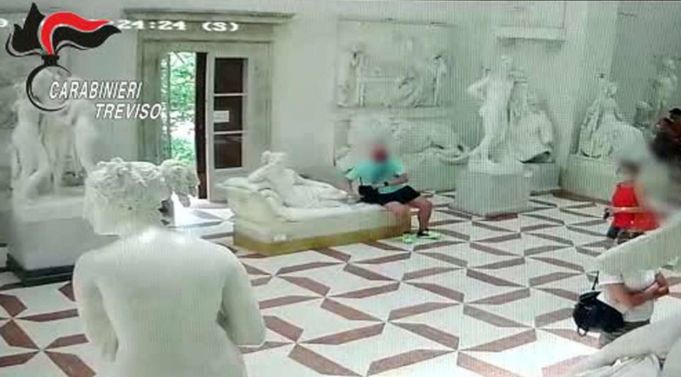
The tourist who damaged the Canova statue.
Within days Italian police managed to track him down, thanks to the Canova museum reservation made by his wife, upon which the 50-year-old man admitted his responsibility, as his case is sent before the public prosecutor's office in Treviso.
- Italy: Tourist climbs onto roof of Pompeii baths for selfie
In mid-August a police investigation began after a tourist climbed onto the roof of a bath house in Italy's archaeological site of Pompeii . The probe was launched after images of the unidentified woman surfaced on the internet, causing a storm of controversy on social media. Police are attempting to establish the identity of the visitor who was photographed while taking selfies on top of the bath house during the Ferragosto holiday.
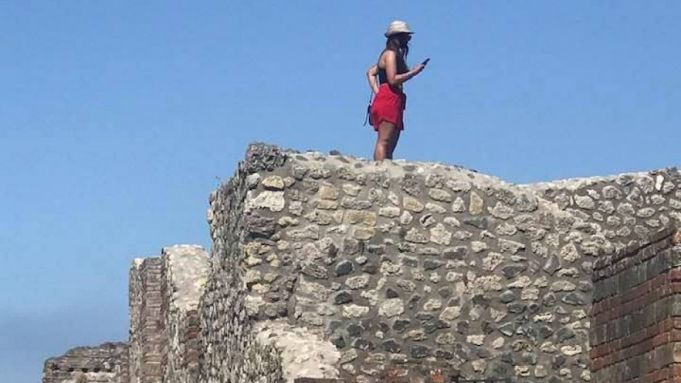
Illegal selfies at Pompeii
The outgoing Pompeii manager Massimo Osanna said the woman's "deplorable" and “uncivil” behaviour was dangerous to both her and the ancient building. If caught, she could face imprisonment from three months to a year, with fines of between €1,000 and €3,000, reports Italian newspaper La Repubblica .
- Rome: tourists fined for engraving names at Trevi Fountain
Several days after this, two tourists, aged 61 and 44, were caught by Rome police as they used a coin to scrape their names into the staircase at the Trevi Fountain . The couple, from Germany and Slovakia, were reported for damaging a site of historical and cultural interest. They also received a fine of €450 and a temporary ban from returning to the monument. Rome mayor Virginia Raggi commended the police for their work, tweeting: "No tolerance for those who deface or damage the monuments of Rome."
- Rome: Tourist carves his initials into Colosseum
The trouble continued right to the end of the summer season. On 20 September a 32-year-old Irish tourist was caught carving his name into the Colosseum where, a few days earlier, a 40-year-old Polish tourist crash-landed his drone inside the ancient amphitheatre despite being reminded beforehand that it was strictly a no-fly zone.
As Italy juggles the fine line between restarting its devastated tourism sector with keeping new covid-19 cases to a minimum, it continues to face the thorny question of how to protect its artistic and cultural heritage from 'vandal tourists' and selfie tourism.
Perhaps the answer lies somewhere between increased vigilance and somehow ensuring that visitors are better prepared for the splendour – precious and fragile – that Italy has to offer.
By Andy Devane
This article is published in the September 2020 online edition of Wanted in Rome magazine . Cover image - photo credit: MarbellaStudio / Shutterstock.com.

Rome's Fiumicino airport best in world for security
Rome's 100 Painters return to Via Margutta
Hanami: Rome's Botanic Garden celebrates spring cherry blossoms
Rome remembers Lord Byron 200 years after his death
Italy's state museums free for Liberation Day on 25 April
Latest Whats'on
Latest Classifieds
Cercasi famiglie ospitanti per studenti statunitensi
SUPER BRIGHT PENTHOUSE 9TH FLOOR WITH HUGE TERRACE!!!
1-bedroom flat utilities included near Via Veneto
Butler/House-Manager
English Language & Literature Teacher
Latest Yellow Pages
Acorn International School
Fairytale and fantasy: Rome's Coppedè quarter
Rome International School
International Elementary School in Rome
Basilica of Santa Maria in Aracoeli in Rome
EVENTS THIS WEEK
Stay connected.

The Wanted Network

Wanted in Milan

Wanted in Europe

Wanted in Africa
Latest What's on

Latest classifieds

More like this Related
Rome's Colosseum welcomes record 12 million visitors in 2023

Rome unveils winning design for New Archaeological Walk
Venice launches online platform for new tourist entry fee
Tourists in Rome toss coins into Roman Forum, Trevi Fountain style
Magician exposes scams targeting tourists in Rome
Rome second in the world for new luxury hotels
Rome set for tourism boom over Christmas and New Year
Tourists in Venice capsize gondola while taking selfies
Wanted in Rome TM
- Things to do in Rome
Wanted in Rome ™ is member of the Wanted World Wide Ltd network. Click here to find out more about our Network or Follow us on social networks.
Wanted in Rome
- User Registration
© 2024 / 2025 Wanted World Wide LTD Network. All Rights Reserved. Made with Kraken PMS.
Current Issue
- Current issue
- Apollo Awards 2023
- 40 Under 40
- 4 Things To See
- Architecture
- Apollo Events
- Photography
- Competitions
Can Italy solve its tourist troubles?
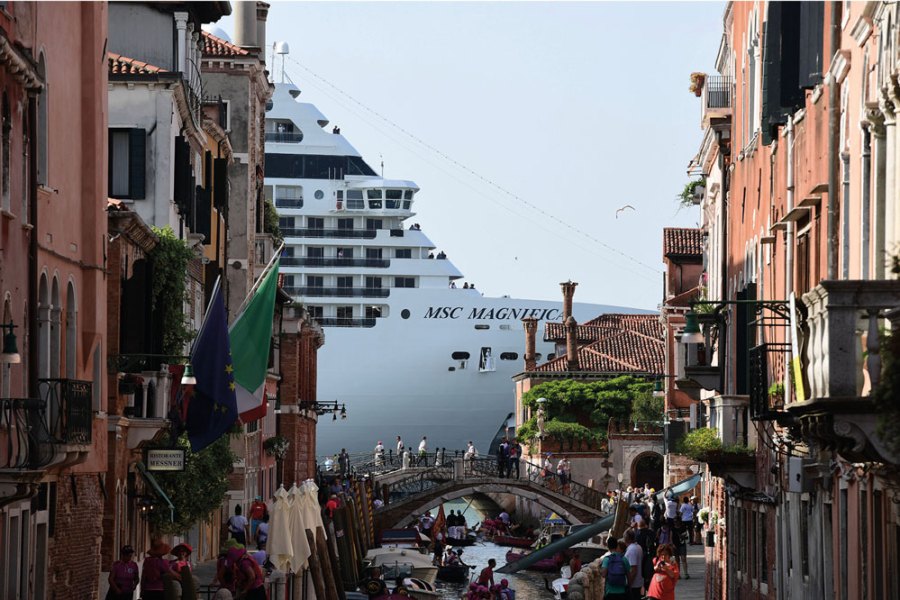
The MSC Magnifica seen from a canal in Venice in June 2019. Photo: Miguel Medina/AFP via Getty Images
From the June 2021 issue of Apollo . Preview and subscribe here .
Last summer, an Austrian tourist hoping to snap a casual picture with a reclining statue of Napoleon’s younger sister ended up crushing some of her delicate plaster toes as he lounged at her feet. This mishap with Antonio Canova’s sculpture of Pauline Bonaparte in a museum in Possagno, northern Italy, is sadly not an isolated incident of reckless behaviour on the part of visitors to Italy – and although the Museo Gypsotheca Antonio Canova may be a little off the beaten track, the story has played into wider discussions of the adverse impact of mass tourism on the country’s heritage.
Such episodes, ranging from foolish antics to acts of serious vandalism, are a staple of heritage debates in Italy. As travel restrictions eased for the first time last June, some of the first arrivals in Venice from overseas caused a furore when they took an illegal dip in the Grand Canal. Backpackers have been chastised for brewing coffee by the Rialto Bridge or – in a city in which it isn’t easy to find a public toilet – using the dark alleyways as latrines. Last year a French tourist left her mark with a felt-tip pen at the Ponte Vecchio in Florence. In Rome, there have been visitors who have taken the Trevi Fountain to be a paddling pool. And at Pompeii last summer, a tourist clambered on to the roof of one of the ancient bath complexes to pose for a selfie. (Archaeological sites have also been prey to light-fingered sightseers; in October last year, a Canadian woman sent back ceramic artefacts she had stolen from Pompeii, claiming that they had cursed her.)
The behaviour of some tourists is clearly a problem. But Italy has long depended on mass tourism, with the sector contributing €237.8 billion to the economy in 2019 – 13 per cent of its GDP. Put another way, that year there were 13 million overnight stays in Venice, 15.8 million in Florence and nearly 31 million in Rome. But the economic benefits of tourism have meant that local authorities have sometimes turned a blind eye to its accompanying problems. So, for instance, much criticism has been levelled at the cruise ships that pass through the Giudecca canal in Venice – damaging the lagoon, causing air pollution, eroding the city’s foundations and facilitating the day-tripper tourism that has overwhelmed the historic centre. But this spring Venice’s mayor, Luigi Brugnaro, and the president of the Veneto region, Luca Zaia, welcomed the first ships to arrive as a ‘good signal’ of post-pandemic recovery – even after the Italian government had issued a decree that banned them from the entering the lagoon.
After more than a year in which the country has oscillated between lockdowns and travel restrictions, Italy’s tourism industry – and the economy as a result – is in crisis. While the return of tourists is essential, local politicians and leaders in the cultural sector are emphasising the need to rethink how visitors interact with heritage. But how far, during the enforced hiatus in tourism, have they actually rethought their strategies to manage visitors and their experience more effectively?
In March this year, the mayors of Florence and Venice set out an extensive strategy hoping to prevent a recurrence of the tourism-related problems of the past. Their proposal calls for better policing, including on-the-spot fines for vandalism of city monuments and the further development of ‘smart control rooms’ to monitor crowds. Venice’s surveillance hub has already been tracking the number of visitors and their nationalities through their mobile phones – which authorities insist accesses no personal data, after concerns were raised about privacy. The hope is that the technology will allow city authorities to activate measures such as turnstiles or to close off busy thoroughfares to non-residents when the system registers tourist congestion.
The strategy document additionally proposes stricter regulation of tourist rental accommodation, which is outpricing locals and causing an exodus of residents from historic centres. Since 2011, both cities have collected a tourist tax for overnight stays to fund improvements to public services; Venice will also soon introduce a tax for day trippers – long mooted, but delayed until 2022 due to the pandemic – that will start at €3 and rise to €10 in peak season. Both mayors intend to curb commercial activities aimed at tourists and give precedence to artisanal businesses and neighbourhood shops. The mayor of Florence, Dario Nardella, called the proposed strategy ‘a new model of tourism also linked to enhancing, promoting and protecting cities of art’.
Some of Italy’s most important museums and heritage sites have also been preparing game plans for more intelligent visitor management. At the Uffizi in Florence earlier this year, director Eike Schmidt announced an innovative project titled ‘Uffizi Diffusi’ (scattered Uffizi) aimed at easing pressure both on the gallery and the city. The initiative involves short, mid and long-term loans of artworks from the Uffizi’s stores to other venues throughout Tuscany, mainly to existing art and heritage institutions. Schmidt hopes the scheme will buoy up destinations throughout the region, tempting visitors to stay in a wider range of locations rather than honing in on the city of Florence. ‘The idea is to slow down tourism, have people stay in the Tuscan countryside for a week if not longer,’ he tells me, ‘which is much healthier not just for the artwork and for us but also for this planet.’
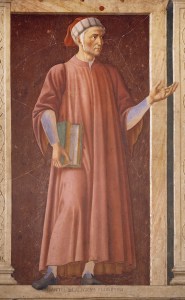
Dante (c. 1448–49), Andrea del Castagno. Uffizi Galleries, Florence
Opening this summer, for instance, is a one-work display of a portrait of Dante by Andrea del Castagno. The painting will be exhibited in the artist’s birthplace, Castagno d’Andrea, in the visitor centre for the surrounding national park. The idea is for visitors to spend an extended period in the location. They can combine natural tourism activities with cultural tourism, and are likely to spend far longer before the painting than if they were squeezing several thousand other works of art into the visit. With exhibitions like this, ‘We hope to be part of a new vision of a more healthy and more in-depth tourism,’ Schmidt says. Further partnerships are likely to be announced soon, with towns including Scandicci and Empoli having expressed interest in taking works on loan. Within the Uffizi itself, new rooms have been opened to ‘add square footage’ and popular works spread out to better manage crowds throughout the building.
The ruins at Pompeii have recently been entrusted to a new director, Gabriel Zuchtriegel. His management proposals emphasise increased vigilance, using drones, satellites and sensors to assist in supervising the site. However, even with technology providing extra eyes in Venice and Pompeii, it is still impossible to monitor the behaviour of all visitors and prevent misdemeanours. Architect Antonio Irlando, who took the photo of the selfie-snapping sightseer on top of the Roman baths, heads up a local association that monitors the state of conservation and visitor interaction at Pompeii’s ruins. Irlando agrees that gadgets and technology can provide additional assistance. Fundamentally, though, sites as large as Pompeii need more custodians and security staff. ‘If a tourist leans against a fresco and damages it, what can a drone do? It is a passive device,’ he says.
Irlando adds, however, that for things to change holidaymakers themselves need to educate themselves in advance about their destinations. ‘We need guidance about how to use and enjoy beauty […] and a natural respect that derives from understanding the importance of the place we are in,’ he says. If tourists were more aware that they are interacting with precious and fragile treasures, with heritage that belongs to all of us, might that inspire more respectful behaviour?
At the Pinacoteca di Brera in Milan, director James Bradburne is taking this idea further. He is determined to eradicate once and for all the disinterested, bucket-list tourism that has been so dominant in recent decades. In order to build stronger links between visitors and the gallery, Bradburne has eliminated single-visit tickets and instead introduced membership cards. These are valid for three months of unlimited gallery visits and a year of online access. The gallery has built an online platform, Brera Plus, with a wealth of complementary content that, Bradburne suggests, ‘may see users from all over the world like the online content so much they never visit the museum in person’.
Members will additionally have the opportunity to express their views on the gallery and its programme, Bradburne explains, including suggesting exhibitions that reflect their interests. The idea is to create a community invested in the museum space and a governing board that listens to the interests of that community. ‘I hope we never go back to the mistakes we made before,’ Bradburne says. ‘Mass tourism was a mistake that created a fragile economy, peaks in visiting, cultural participation that was very trivial and superficial. It turned Italy from a nation of creative designers to a nation of winemakers and restaurant waiters.’
Increased policing and vigilance at historic sites is no doubt an important step in curbing touristic negligence, but Bradburne’s initiative at the Brera points to a potentially more effective solution, one in which prevention is better than cure. It advocates for a change in the very concept of being a visitor. Instead of just passing through without leaving a trace – or, worse, leaving a damaging one – the visitor enters a ‘contract’ with the museum or heritage site. And that’s not just a monetary investment; it’s also a pledge of care.
Recommended for you
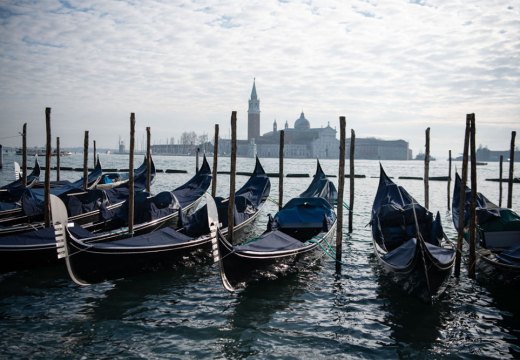
For the gondola builders of Venice, choppy waters lie ahead
Traditional boatyards and boat-building techniques have long been in decline – but the pandemic has only worsened the situation
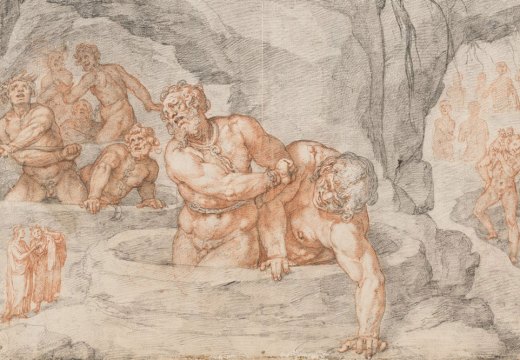
Dante has stumped many an artist – but these delicate drawings are truly divine
Federico Zuccari’s illustrations of the Divine Comedy have seldom been shown. But the Uffizi has put them online – and Dante’s poem has never looked better
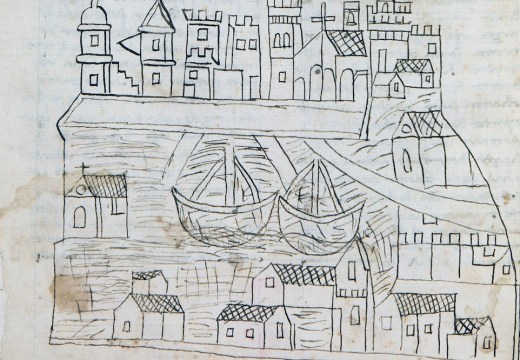
What did Venice look like to a medieval pilgrim from Tuscany?
A 14th-century sketch by a travelling friar is now thought to be the earliest known drawing of the city

Most popular

Jef Verheyen’s brush with the infinite
Emma Crichton-Miller

Fjord focus – how Ibsen inspired the art of Edvard Munch
Joanna Kavenna

Space explorer – an interview with Kapwani Kiwanga
Edward Behrens

Who really pays for public exhibitions?
Jane Morris

How Adriano Pedrosa is opening up the Venice Biennale

The basic instincts of Benjamin Franklin

Former Uffizi director Eike Schmidt runs for mayor of Florence

Phoenix Kingdoms: The Last Splendor of China’s Bronze Age
![mass tourism rome Masterpiece [Re]discovery 2022. Photo: Ben Fisher Photography, courtesy of Masterpiece London](https://www.apollo-magazine.com/wp-content/uploads/2022/07/MPL2022_4263.jpg)
The Masterpiece podcast: episode three
This episode explores an ancient funeral stele, Marie Antoinette’s breast bowl, and how digital technologies are helping to preserve Egyptian heritage sites
Art news daily
The week in art news – marlborough gallery to close after nearly 80 years, nicholas cullinan appointed director of the british museum, latest comment, why are fathers so absent from art history, museums should do more to cater for autistic people, richard serra, man of steel (1938–2024).
- About Apollo
- Advertise with us
- Terms and Conditions
Overloaded by Airbnbs and mass tourism, Rome fears its historic centre will be emptied out of locals
As more neighbourhoods are transformed to cater to travellers, many residents are leaving because of pressures on the housing market, retailers and their way of life
This article was published more than 6 months ago. Some information may no longer be current.

At her apartment in the Monti neighbourhood of Rome, Chiara Rapaccini sits on the mattress in her kitchen where she sometimes goes to avoid the noise of busy nightlife. 'The worst are the Americans,' she says of the tourists. 'They get drunk outside and make a lot of noise.' Photography by Fabrizio Troccoli/The Globe and Mail
The second-floor apartment of Italian artist and author Chiara Rapaccini faces what used to be a tranquil street in the heart of Monti, a bewitching little quarter near the Roman Forum and Colosseum that has existed since ancient times and, until about 15 years ago, felt as serene as a Tuscan village.
Today, tourist hell would be a better description.
Ms. Rapaccini’s cobblestone street buzzes all day and night with tourists stumbling in and out of bars, shabby restaurants that cater to visitors, not locals, and Airbnbs. On a few nights, she finds the noise so unbearable that she drags a small mattress into her kitchen, at the back of the apartment, where it is quiet enough to sleep. “We are new to this confusion, this chaos,” she told me from her nearby art studio. “The worst are the Americans. They get drunk outside and make a lot of noise.”

Chiara Mogavero says she's noticed more noise since Airbnbs came to her building in Rome.
In Prati, a fairly elegant district dating from the early 20th century just beyond the Vatican City, Chiara Mogavero, a Roman-born painter and former dancer, so dislikes what has happened to her ‘hood’ – and Rome in general – that she plans to move to Paris.
She thought her apartment block, located in a pleasant but untouristy section, would be immune from the Airbnb onslaught. She was wrong.
Five Airbnbs recently opened in her five-storey building, one of them smack next door. Her building is losing its sense of community as the locals leave and short-term visitors take over. She, too, can’t stand the constant noise. “You can hear doors slamming all the time, even at night. I can hear strangers talk next door, their music. It’s like living in a video game.”

Tourists crowd the streets of Rome.
Both Chiaras, and many other Romans who live in, or close to, Rome’s historic centre fear that their beloved city is turning into the next Venice. By that they mean a centre overwhelmed with tourists and Airbnbs that are pushing out the locals and the shops and services that they depend on for quotidian life. Romans need hardware stores, dry cleaners and butchers; they don’t need more pubs, cheap pizzerias and ice-cream shops – or neighbours who are complete strangers. “As Romans leave, there are fewer and fewer people left to defend their neighbourhoods,” Ms. Mogavero said.
I can empathize. When my family and I moved to Italy from Toronto 16 years ago, Rome was certainly touristy but there was no 24/7/365 deluge of visitors in every corner of the centre, and no Airbnbs. We live on the inside southern edge of Rome’s historic centre, near the headquarters of the UN’s Food and Agriculture Organization and the Circus Maximus. Back then, the streets and main drags near us were full of useful shops. We never had to jump in the car to buy anything essential.
In recent years, most of these retailers have gone, replaced by bars, restaurants (almost all of the non-Italian variety) and ice-cream parlours. The hardware store has vanished, along with the dry cleaner, the auto-parts store and the mechanics’ shop. We cannot even buy a lightbulb or a wrench nearby. We hear less Italian on our streets and more English, Spanish, German and Chinese.
The historic centre proper – one of the largest in the world – is getting hollowed out. The boulevards, squares and narrow streets are stuffed with chain stores that mostly cater to visitors (everything from McDonald’s to the Gap), endless pizzerias and restaurants with street barkers touting “tourist menus,” slow, open-top tour buses that make Roman drivers insane, junk shops that sell boxer shorts emblazoned with the penis of Michelangelo’s David, and, most of all, Airbnbs. In May, Starbucks opened its first outlet in the historic centre and serves an alien drink that appalls Romans – Frappuccinos.

Iconic Roman landmarks, from the Trevi Fountain and Piazza Navona to Vatican City and the Pantheon, are busy once again after Italian authorities – eager to make up for the years of COVID-19 restrictions – adopted measures to stimulate the tourist trade.
More than any other factor, the short-term rental phenomenon – Airbnb is the biggest but not the only such service – is ripping the fabric of the city, all the more so now that tourism is back to its prepandemic levels. The Pantheon alone is getting 35,000 to 40,000 visitors a day, according to its security guards. “More and more Romans are leaving because the city centre is becoming too crowded and expensive,” said Amadeo Biagila, a former policeman who runs crowd control at the 1,900-year-old Roman temple.
Families who have lived in the heart of Rome for generations are packing up. The population of the historic centre has fallen by 20,000, to less than 170,000, in the last three decades, with most of the decline coming in the last 10 years or so, roughly coinciding with the arrival of Airbnb (the population of metro Rome is 4.3 million).
The defenders of the city say the Airbnb saturation – they call it “desertification” – is turning Rome into an architectural theme park: baroque bits here, ancient bits there, selfie-taking tourists in between, fewer and fewer Romans.
Some local politicians, along with anti-tourist and anti-Airbnb community groups, are fighting the trend. They are calling for a national law to put limitations on short-term holiday rentals, since Italian cities are virtually devoid of any restrictions on them.

Municipal councillor Nathalie Naim lives in Monti and has tried to slow the spread of Airbnbs there.
Nathalie Naim, an Italian-Canadian municipal councillor for the historic centre of Rome – she lives in Monti – has been fighting the degradation of her neighbourhood for years. She has fought the new liquor licences that allow businesses that normally don’t sell booze, such as art galleries, to do so. Her pitch for laws that would slow or stop the proliferation of Airbnbs has so far gone unheeded, though she is picking up political allies. “Italy has no brakes for short-term rentals,” she said. “It’s all about making money.”
The restrictions she and other councillors have suggested include a ban on new short-term rental listings, capping the number of listings in certain areas, limits on the proportion of apartments per building that can be rented to tourists, and, like many cities in Europe, limiting the number of days each year that homes can be rented. London imposed an annual cap of 90 days for which hosts can rent out their properties. The limit in Paris is 120 days. In Amsterdam, entire homes can be rented out for only 30 days a year. In Rome, zero limits.
A data-driven site devoted to monitoring the impact on residential neighbourhoods by Airbnbs – insideairbnb.com – lists almost 25,000 of them in Rome. Most of them are clustered in, or on the edges of, the historic centre, with the Trastevere, Piazza Navona, Pantheon, Trevi Fountain and Vatican areas clotted with them.
The true number of Airbnbs is probably thousands higher, since many are thought to be unregistered. Some hosts lease apartments so they can rent places they do not own. Inside Airbnb says that two-thirds of hosts in Rome have multiple listings. One short-term rental agency, Iflat, lists 239 Airbnb options.
Maria Luisa Mirabile is a Rome sociologist who, as a member of the local Monti Committee, has written a report on short-term rentals called “Rome, A City Too Open.” She said the sheer number of tourists is not in itself the problem; the problem is that they – and the Airbnbs they use – are concentrated in a small area.
The municipal and national governments, she said, could have used the 2020 and 2021 pandemic years, when tourism fell to almost zero, to decide what kind of visitors they wanted to bolster the economy.
They chose mass tourism of the kind that allowed thousands of apartments to be offered to short-term visitors – and opened the market for thousands more.
Her report says that the short-term rentals resulted in the “substitution of the resident population with a passing population without a memory of the past nor an interest in the future of these places.”

'Why call it tourist season if we can't shoot them?' asks a sign in Monti affixed beside a notice of complaints from a neighbourhood group about tourism.
:format(jpeg)/cloudfront-us-east-1.images.arcpublishing.com/tgam/VE4NY5AWWRHHJMEB5SBSLHDDHI.jpg)
In her studio, Ms. Rapaccini sits on a chair with the inscription 'this lady is waiting for someone who won't come because he went to the lady next door.' She has lived here in Monti since the 1980s.
Ms. Rapaccini remembers when Monti was a quiet, authentic haven for arty types and locals. She and her late partner, the film director Mario Monicelli, who received six Oscar nominations, moved to Monti in 1988. The area was unfashionable, dirty and full of prostitutes, but beautiful in its gritty way, “like a little village” even though it was in the heart of a big, bustling city, she recalls. The apartments were cheap and the area began to attract film types, journalists and artisans – none of them rich – who mixed easily with local workers and shop owners.
Then Monti began to change. It was being discovered and the money began to flow in. Ms. Rapaccini and Mr. Monicelli decided to make a short film about their little world. “We understood that we had to record what Monti was like before it all went away,” she said.
The film, Near the Colosseum, there is Monti , released in 2006, shows scenes of everyday life: a barber shaving men’s beards, young boys swinging their arms at one another in a grungy boxing club, an orchestra performing on the streets, old men playing cards on an outside table, nuns and priests toing and froing, carpenters working in their ateliers, chefs cooking honest peasant food in simple restaurants, nary a tourist in site.
The couple was right. Monti would soon change its personality completely, becoming, to their alarm, more like Trastevere, the ancient area on the left bank of the Tiber River, just south of the Vatican. Trastevere 50 years ago was like Monti 20 years ago. Today, Trastevere is a constant party, packed with tourists, Airbnbs, noisy bars and streets full of trash and broken beer bottles.
Ms. Rapaccini sees Monti taking the same route. She invented a word for its transformation: Trasteverizzato, a play on Trastevere and terrorized. “It’s impossible to change this situation in Rome,” she said. “It’s all about money, money, money, not preservation. More tourism, more alcohol, more Airbnbs. I am so sad about this.”
Tourism: More from The Globe and Mail
The decibel podcast.
Air travellers are bracing for chaos this summer after airlines scheduled bigger, more frequent flights, despite shortages of labour and resources. Subscribe for more episodes.
Travel done differently
Hidden Canada 2023: The 10 best under-the-radar places to visit
Six European travel destinations to avoid the summer crowds
How nature-focused vacations connect travellers to their destination
Follow related authors and topics

- Communities and cultures Follow You must be logged in to follow. Log In Create free account
- Money Follow You must be logged in to follow. Log In Create free account
Authors and topics you follow will be added to your personal news feed in Following .
Interact with The Globe
The leafs will fall to the bruins. everyone knows it, the failure of canada’s health care system is a disgrace – and a deadly one, toronto zoo says ‘friendly and determined’ snow leopard jita is pregnant, saskatchewan education minister apologizes for comment to mother whose daughter died, israel launches retaliatory strike on iran: reports, he keeps ‘a few thousand in crisp new bills’ at home - is that a good idea, rbc economist robert hogue on where housing prices are heading - and why affordability won’t make a quick return, how many employees has the federal government hired since 2015 take our business and investing news quiz.
This is how travel hotspots are fighting back against overtourism

The clampdown comes amid a global travel boom. Image: REUTERS/Tony Gentile
.chakra .wef-1c7l3mo{-webkit-transition:all 0.15s ease-out;transition:all 0.15s ease-out;cursor:pointer;-webkit-text-decoration:none;text-decoration:none;outline:none;color:inherit;}.chakra .wef-1c7l3mo:hover,.chakra .wef-1c7l3mo[data-hover]{-webkit-text-decoration:underline;text-decoration:underline;}.chakra .wef-1c7l3mo:focus,.chakra .wef-1c7l3mo[data-focus]{box-shadow:0 0 0 3px rgba(168,203,251,0.5);} Johnny Wood

.chakra .wef-9dduvl{margin-top:16px;margin-bottom:16px;line-height:1.388;font-size:1.25rem;}@media screen and (min-width:56.5rem){.chakra .wef-9dduvl{font-size:1.125rem;}} Explore and monitor how .chakra .wef-15eoq1r{margin-top:16px;margin-bottom:16px;line-height:1.388;font-size:1.25rem;color:#F7DB5E;}@media screen and (min-width:56.5rem){.chakra .wef-15eoq1r{font-size:1.125rem;}} Travel and Tourism is affecting economies, industries and global issues

.chakra .wef-1nk5u5d{margin-top:16px;margin-bottom:16px;line-height:1.388;color:#2846F8;font-size:1.25rem;}@media screen and (min-width:56.5rem){.chakra .wef-1nk5u5d{font-size:1.125rem;}} Get involved with our crowdsourced digital platform to deliver impact at scale
Stay up to date:, travel and tourism.
Rome is cracking down on “gladiators” and street drinking in an attempt to keep the excesses of tourism in check. The clampdown comes amid a global travel boom that has resulted in popular destinations groaning under the strain of hordes of tourists.
Modern-day Romans in full gladiator costume used to stand outside sites like the Colosseum, posing for photographs with tourists eager to part with their money. But recently the city passed new legislation aimed at curbing this practice. The new measures are part of Rome city council’s efforts to clean up the capital’s streets and protect its heritage. Visitors caught swimming or wading in the Trevi fountain – as Anita Ekberg did in the classic film La Dolce Vita – have incurred fines of €450 ($500). City authorities have also outlawed drinking in public after 10pm and stopped bars and nightclubs serving alcohol between 2-7am. Police officers have new powers to fine offenders or ban them temporarily from a specific area.

Rome is just one of many destinations where local authorities are looking for ways to tackle unruly behaviour as they struggle with increasing visitor numbers.
A global problem
The village of Kinderdijk, a Unesco-recognized site in The Netherlands, is also facing an influx of visitors, attracted by its windmills, dykes and picturesque scenery. Some local residents have taken to distributing postcards asking tourists to consider the impact of their visit. The year-round mass tourism generates income for Kinderdijk, but the village’s infrastructure is overwhelmed, despite a ban on coaches entering its centre. The town is home to just 60 residents, yet attracts around 600,000 visitors per year.
Sardinia is suffering a different type of problem as a result of tourism: sand disappearing from its golden beaches. Visitors to the Italian island now face fines of between $580 and $3,500 if they take sand as a holiday souvenir. Tourists may not realize that removing a container of sand damages the island’s ecosystem and the aim of the fines is to raise public awareness. Elsewhere in Italy, the traditional village of Polignano a Mare, in Puglia, has set up turnstiles to charge visitors an entry fee during the popular festive season. The €5 ticket price, which includes popcorn, doughnut, candy floss and a drink, aims to encourage tourists visiting in the summer months to return in the off-season.
Have you read?
Overtourism is becoming a major issue for cities across the globe, wish you weren’t here: what can we do about over-tourism, the number of tourists that visit japan has increased by more than 20 million in five years.
Sustainable tourism
In 2017 authorities introduced a code of conduct for visitors to Ho Chi Minh City in Vietnam. Published in five languages, the code advises visitors on laws, regulations and customs with the aim of promoting respect for local places and people. Plans are in place to create a similar code of conduct to educate locals about how to interact with foreign visitors. Thai authorities have taken more extreme measures, closing Maya Bay – the famed location for the film The Beach – to visitors. The idyllic spot in the Phi Phi Islands attracted up to 5,000 people each day , overcrowding the small bay and causing damage to the surrounding reef. It remains to be seen if a temporary closure will be sufficient to reverse the damage to the local marine ecosystem.
A delicate balance exists between the positive economic contribution that mass tourism makes and its potentially harmful impact on local customs, ways of life, infrastructure and the environment.
Direct and total contribution of travel and tourism to global economy 2006-2017 (trillion US dollars)

As the chart above shows, the direct economic contribution of global travel and tourism reached approximately $2.57 trillion in 2017.
The World Economic Forum’s Travel & Tourism Competitiveness Report 2017 calculates that for every 30 new tourists to a destination, one new job is created. The industry accounts for 30% of world services exports and is a major employment generator.
But unless tourism can be made more sustainable, the future cost to local traditions, lifestyles and ecosystems could become too high a price to pay.
Don't miss any update on this topic
Create a free account and access your personalized content collection with our latest publications and analyses.
License and Republishing
World Economic Forum articles may be republished in accordance with the Creative Commons Attribution-NonCommercial-NoDerivatives 4.0 International Public License, and in accordance with our Terms of Use.
The views expressed in this article are those of the author alone and not the World Economic Forum.
Related topics:
The agenda .chakra .wef-n7bacu{margin-top:16px;margin-bottom:16px;line-height:1.388;font-weight:400;} weekly.
A weekly update of the most important issues driving the global agenda
.chakra .wef-1dtnjt5{display:-webkit-box;display:-webkit-flex;display:-ms-flexbox;display:flex;-webkit-align-items:center;-webkit-box-align:center;-ms-flex-align:center;align-items:center;-webkit-flex-wrap:wrap;-ms-flex-wrap:wrap;flex-wrap:wrap;} More on Travel and Tourism .chakra .wef-17xejub{-webkit-flex:1;-ms-flex:1;flex:1;justify-self:stretch;-webkit-align-self:stretch;-ms-flex-item-align:stretch;align-self:stretch;} .chakra .wef-nr1rr4{display:-webkit-inline-box;display:-webkit-inline-flex;display:-ms-inline-flexbox;display:inline-flex;white-space:normal;vertical-align:middle;text-transform:uppercase;font-size:0.75rem;border-radius:0.25rem;font-weight:700;-webkit-align-items:center;-webkit-box-align:center;-ms-flex-align:center;align-items:center;line-height:1.2;-webkit-letter-spacing:1.25px;-moz-letter-spacing:1.25px;-ms-letter-spacing:1.25px;letter-spacing:1.25px;background:none;padding:0px;color:#B3B3B3;-webkit-box-decoration-break:clone;box-decoration-break:clone;-webkit-box-decoration-break:clone;}@media screen and (min-width:37.5rem){.chakra .wef-nr1rr4{font-size:0.875rem;}}@media screen and (min-width:56.5rem){.chakra .wef-nr1rr4{font-size:1rem;}} See all

How Japan is attracting digital nomads to shape local economies and innovation
Naoko Tochibayashi and Naoko Kutty
March 28, 2024

Turning tourism into development: Mitigating risks and leveraging heritage assets
Abeer Al Akel and Maimunah Mohd Sharif
February 15, 2024

Buses are key to fuelling Indian women's economic success. Here's why
Priya Singh
February 8, 2024

These are the world’s most powerful passports to have in 2024
Thea de Gallier
January 31, 2024

These are the world’s 9 most powerful passports in 2024

South Korea is launching a special visa for K-pop lovers
- International edition
- Australia edition
- Europe edition

‘What rules today is money’: Rome’s five-star hotel boom
High-end tourism is back in Italian capital but there are concerns over how ‘incredible rebirth’ is being managed
“R ome is now the city of luxury hotels,” said Giuseppe Botrugno as he served his loyal crowd of lunchtime customers, mostly office workers who pile into the humble bar and eatery for affordable, no-nonsense Roman fare.
“There is one opposite, one around the corner, and another planned next door to that one,” added Botrugno, who along with his brother has run Bar San Marcello on Via di San Marcello, a narrow street close to the Trevi fountain, for more than two decades.
They have seen plenty of changes in the neighbourhood, most recently the boom in five-star hotels.
Opposite the bar is Palazzo Salviati Cesi Mellini, a 15th-century building with a Unesco-listed facade that now hosts the well-heeled guests of Six Senses, as the first location in Italy for the international chain. In another ancient complex around the corner is Umiltà 36, a Shedir Collection hotel. Down the road from that, a building that until Friday was the headquarters of Rome’s foreign press association is being vacated to make way for the neighbourhood’s next five-star offering.
On the one hand, Botrugno is pleased that Palazzo Salviati Cesi Mellini, which lay abandoned for years, has sprung back to life. “It gives some lustre to the city,” he said. On the other, he wonders if such an abundance of luxury might diminish the eternal city’s spirit. “The move in this direction is inevitable, as what rules today is money,” he said.

Rome’s leaders are certainly making the most of it. The Italian capital came second after London for luring the world’s top luxury hotels in 2023, according to a report by Luxury Travel Intelligence. A Bulgari hotel opened with a star-studded party in June last year, while 13 more are on the way before 2026. They include a Four Seasons hotel, a brand partly owned by Bill Gates, which will be accommodated in a Renaissance-era building close to the Vatican, and the Robert De Niro-backed Nobu Hotel Roma on Via Veneto.
After a period of negative press, mostly due to its waste management woes , the city’s mayor, Roberto Gualtieri, said the influx of luxury hotels proved that Rome “has become attractive again”.
Maurizio Veloccia, Rome’s urban planning councillor, said that not since the 1960s and 70s when Via Veneto was at the centre of the dolce vita had there been such a high interest in the city from the luxury sector. “Rome has always been a city to see at least once in a lifetime, but until recently, compared to Paris and London, it was not attracting the hotels or visitors of a certain, shall we say, class,” he said.
In Rome 2023 was a record year for tourism, with visitor numbers eclipsing 2019. A person working for a luxury hotel said there was a renewed sense among its guests of “wanting to live life to the full” after the Covid-19 crisis. Big events such as last September’s Ryder Cup and sell-out concerts have been a major draw.
“Rome is experiencing an incredible period of rebirth, and especially in high-end tourism,” said Tommaso Tanzilli, the director general of the Rome and Lazio unit of the Federalberghi hotels association. “But not only are we closing the gap in luxury hotels but hotels at all levels are doing well.”

However, the heavy focus on luxury isn’t welcomed by everyone. Vanna Mannucci, an adviser at the Rome unit of the a heritage group Italia Nostra, said it might push even more residents and small to mid-range businesses away from the centre. “Without residents, the city dies,” she said. “It will also squeeze out smaller hotels offering rooms to those who can’t afford to pay €500 a night.”
after newsletter promotion
Her Italia Nostra colleague, Riccardo D’Aquino, expressed concern about alterations being made to the city’s historic buildings in order to accommodate high-end tastes, citing the Six Senses, where Roman-style baths were built on the first floor. “The economic needs are understandable, we can’t live without tourism,” he said. “What worries me is that this change is not being well managed.”
The luxury arrivals have also triggered the wrath of owners of small and medium-sized hotels, who argue that international investors are being given preferential treatment, such as being granted permits more swiftly. “Whereas I’ve been trying to update our licence for years,” said Steve Brenner, of the Beehive hostel, close to Termini station. “It kind of pisses us all off as we feel that small hotels are the city’s bread and butter. We collect the tourist taxes for them, but yet we are treated differently.”
Brenner said the city was not equipped to offer the kind of service a five-star guest wants. “We don’t have enough taxis, we don’t have the infrastructure, even down to the water and electricity.”
Sergio Franci, the owner of Antica Stamperia Trevi, a printing shop that has been on Via dell’Umiltà since 1780, welcomed the top hotels but said not enough was being done to conserve Rome’s historic businesses. Mass tourism has taken its toll on the city, and although the rubbish crisis has slightly eased in the historic centre in recent years, it remains an issue for the neighbourhoods beyond.
“Rome doesn’t have the dignity that a capital city deserves,” said Franci. “Rome needs more than five-star hotels – it needs a long-term vision.”
- Rome holidays
- Hospitality industry

Tourist from England accused of carving name in Colosseum says he did not realise its age
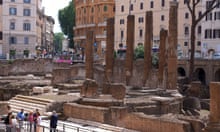
Et tu, Caesar: legendary site of dictator’s murder now open to Rome tourists

Rome’s solar-powered Christmas tree lights spark row over ‘ugly’ panels

American tourist fined for eating ice-cream on steps of Rome fountain

US tourist throws scooter down Rome’s Spanish Steps, causing €25,000 damage

Rome’s cultural elite write to Unesco over ‘mortifying’ scenes of rubbish
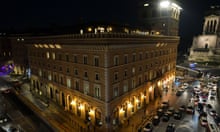
Tourist crashes drone into Rome monument in latest mishap
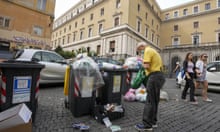
‘In Rome, nothing works’: citizens despair in run-up to mayoral elections
Most viewed.
- Entertainment
- Sports Sports Betting Podcasts Better Planet Vault Mightier Autos Newsletters Unconventional Vantage Experts Voices
- Subscribe for $1
- Sports Betting
- Better Planet
- Newsletters
- Unconventional

Traveling to Italy? These Cities Are Fighting Against Mass Tourism
Venice is not simply sinking—it's flooded with tourists and the city's mayor is willing to do whatever it takes to regulate the wave of visitors, including closing down certain streets and bridges.
The Easter weekend, at the beginning of April, saw thousands of tourists crowding Venetian streets and traditional canal ferries known as vaporetti , with local media reporting "a river of people" of an "unprecedented" proportion creating delays and long lines.
Mass tourism is not a new phenomenon for Italy, but the number of visitors to the "Bel Paese" is increasing to a point where several cities are wondering whether the inconvenience created to local residents is worth putting up with.
Venice Mayor Luigi Brugnaro has been campaigning for more regulation since he was elected three years ago. In 2016, he won the government's support to install turnstiles at strategic locations in the city to regulate the influx of visitors.

But increased numbers of tourists during the holiday weekends and summer holidays are still proving difficult to manage. To avoid the Easter weekend crowding, Brugnaro limited access to certain areas of the city, and he relocated arrivals by ferry to areas farther from the city center.
The city launched the #EnjoyRespectVenezia campaign to increase public awareness of the crowding situation, including an infographic that shows the expected level of visitors for any day of the year.
"We don't want to block access to the city, but we need to regulate the influx during particularly busy days," the mayor said in a video shared on his Twitter page. Earlier in April, he compared his efforts to President Donald Trump's "America First" campaign. "It's what I'm trying to do in Venice, too," the mayor said at an event in April . "He puts American interests first, I do the same for those Venetians who care about their city."

Venice's problems echoed in Capri, a small island in the Gulf of Naples often listed among the world's most beautiful places. Its reputation brings as many as 4 million visitors to the island of 12,000 residents every year.
Capri mayor Giovanni de Martino has long been flagging the unregulated influx of ferries from the mainland as an issue for the township and expressed frustration at the lack of support the island has received so far.

"Unfortunately, our appeal has not been given the right consideration because we think the solution could be fairly easy," de Martino told Newsweek . Rather than turnstiles, for which there is hardly any space, de Martino is advocating for reducing the frequency of the ferries bringing hundreds of visitors from the mainland, which only have the small Marina Grande harbor as a docking area and point of connection to the rest of the island, creating lines and traffic congestions.
"When [the ferries] arrive almost all at the same time, there is no possibility to let them disembark in a timely manner, so you have long queues, chaos, and, naturally, protests and frustration from those who have to wait," De Martino explained. A project to increase the harbor area is in the planning phase, according to the mayor, but that wouldn't solve the issue because of the limited size of the island.
For de Martino, one solution is simply to change the arrivals' timetable, but that is something that Capri authorities cannot control as it is a prerogative of the regional government and the Coast Guards.

One of the other thorns in the mayor's side are those visitors who only come to the island for a few hours, especially cruise ship travelers. "Ideally, stay the night," the mayor advised. "There's a saying that goes 'One should see the sunset in Capri.' There [are] so many attractions that they should be staying for longer to fully appreciate their beauty."
Florence and Rome
While cities like Florence and Rome aren't limited by the territorial constraints afflicting Venice and Capri, those cities too have been struggling with containing disruptive behavior.
Last year, Florence Mayor Dario Nardella instructed the city's cleaners to hose down church steps at lunchtime to prevent people from sitting down to consume their meal—a plan that did not fully account for the warm midday sunshine that quickly dried the pavement, but managed to attract international attention .

In Rome, Mayor Virginia Raggi faced an even bigger hurdle to her goal of regulating visitors' behavior in some of the city's hotspots, such as introducing a ban on stops at the Trevi Fountain to admire its baroque style—a total failure of enforcement, as some Italian media reported.
Elsewhere in Europe
Florence and Rome are also struggling to face the increase of unregulated tourism rentals via services like Airbnb, as Business Insider Italia noted, that not only deprive the city of taxes otherwise imposed on hotels and other regulated forms of tourist accommodation, but also reduce the supply of housing available to locals, pushing up costs.
The issue is felt across tourism hotspots in Southern Europe, from Croatia to Spain, as The Guardian reported in August. Palma, the largest city on the Spanish island of Mallorca, banned homeowners from renting their apartments to tourists last year after anti-tourism protests affected the island, as well as neighboring Ibiza and the city of Barcelona across the Balearic Sea.
Uncommon Knowledge
Newsweek is committed to challenging conventional wisdom and finding connections in the search for common ground.
About the writer
Sofia Lotto Persio reports mainly on Asia and gender issues for Newsweek. She previously covered international affairs with a specific focus on Europe and the Middle East for IBTimes UK. She follows politics, conflict, terrorism, immigration, human rights and gender-based violence. She has previously reported on global trade finance and fintech at Global Trade Review and written about LGBT rights in Italy for the Economist Intelligence Unit.
To read how Newsweek uses AI as a newsroom tool, Click here.

- Newsweek magazine delivered to your door
- Newsweek Voices: Diverse audio opinions
- Enjoy ad-free browsing on Newsweek.com
- Comment on articles
- Newsweek app updates on-the-go

Top stories

China Building New Outpost on U.S. Doorstep, Leaked Documents Reveal

Republicans Join Democrats on Foreign Aid Bills in 'Incredibly Rare' Move

Mysterious Accidents at US, Ally's Defense Facilities Spark Sabotage Fears

California Insurers Cutting Hundreds of Policies Over Historic Risk

Dispatch: Without Tourism, Italy’s Economy Faces Disaster
Create an FP account to save articles to read later and in the FP mobile app.
ALREADY AN FP SUBSCRIBER? LOGIN
World Brief
- Editors’ Picks
- Africa Brief
China Brief
- Latin America Brief
South Asia Brief
Situation report.
- Flash Points
- War in Ukraine
- Israel and Hamas
- U.S.-China competition
- Biden's foreign policy
- Trade and economics
- Artificial intelligence
- Asia & the Pacific
- Middle East & Africa
Inside the GOP’s Foreign Policy
Ones and tooze, foreign policy live.

Spring 2024 Issue
Print Archive
FP Analytics
- In-depth Special Reports
- Issue Briefs
- Power Maps and Interactive Microsites
- FP Simulations & PeaceGames
- Graphics Database
The Atlantic & Pacific Forum
Principles of humanity under pressure, fp global health forum 2024, fp @ unga79.
By submitting your email, you agree to the Privacy Policy and Terms of Use and to receive email correspondence from us. You may opt out at any time.
Your guide to the most important world stories of the day
Essential analysis of the stories shaping geopolitics on the continent
The latest news, analysis, and data from the country each week
Weekly update on what’s driving U.S. national security policy
Evening roundup with our editors’ favorite stories of the day
One-stop digest of politics, economics, and culture
Weekly update on developments in India and its neighbors
A curated selection of our very best long reads
Without Tourism, Italy’s Economy Faces Disaster
Foreign visitors have helped prop up the faltering italian economy. if they don’t come back, the country is in trouble..
MILAN, Italy—On Feb. 16, twenty-year-old Linda Pani launched herself from St. Mark’s bell tower, hooked to a metal cable, and descended to the center of the square. It was the kickoff ceremony of Venice’s Carnival.
For the city’s economy, the weeklong Carnival is the most important event of the year, attracting up to 3 million visitors , filling hotels and Airbnbs, and bringing approximately 3 billion euros ($3.3 billion) in revenue each year. But three days later the celebrations were canceled due to the coronavirus pandemic sweeping the country.
For Venice, it was the beginning of an economic crisis.
Tourism is “Italy’s oil,” so goes a popular saying, a mantra that Italian politicians tend to repeat quite often , including League secretary Matteo Salvini and Luigi Di Maio, the former leader of the Five Star Movement.
Tourism in Italy today amounts to 13 percent of the country’s GDP. It has created jobs, spurred development, and injected cash flow into the national economy.
But Italy isn’t exactly the tourist version of a petrostate. Unlike the Gulf kingdoms whose whole economies rest on a single product, Italy has a diversified, if embattled, economy: It has the second largest manufacturing output in the European Union, largely concentrated in the wealthy northern regions, and it’s well known for its export of wine, food, and luxury goods including designer clothes and high-end cars.
When people say tourism is Italy’s oil, they’re thinking more of Texas than Saudi Arabia. Tourism is a major source of income and has energized a broader economy with a trickle-down effect. Four million Italians are currently working in tourism or tourism-related activities, a significant portion of the country’s overall 23 million workforce .
It’s not that tourism is all that Italy has got. It’s that tourism is what is keeping Italy’s economy afloat. Last year, for instance, Italy’s industrial output shrank by 2.4 percent while tourism grew by 2.8 percent .
Italy has been a tourist destination for centuries, but the industry’s central role in the economy is a more recent phenomenon. Especially since Italy’s economy has stagnated for decades, and was particularly hit by the 2011 European financial crisis, tourism has provided a much-needed lifeline.
In a country plagued by unemployment, tourism offered jobs for guides, restaurateurs, waiters, cooks, and cleaners. The fact that Italy has a high percentage of home ownership allowed many families to turn their apartments or weekend houses into bed-and-breakfasts or Airbnbs. In the aftermath of the crisis, tourism provided a social safety net.
But the coronavirus lockdown changed all that—in Venice and across the country. For the first time in recent history, the city that was most ravaged by overtourism found itself with no tourists at all. And since Venice’s whole economy revolves around mass tourism, the sudden transition has already resulted in a massive employment crisis: 20,000 jobs have been lost in the area.
But Venice is far from being an isolated case in Italy. Florence and Rome are facing similar situations. In fact, Florence’s mayor said he’s thinking of mortgaging some of the city’s historical monuments—effectively telling banks, if the city can’t pay its debt, take the Uffizi Gallery.
The crisis is real in Florence; the Tuscan city used to draw $52 million in tourism taxes each year (that hotels or Airbnb hosts pay for each day a guest stays), but this year there will be almost no tourism tax revenue, so the city has no way to pay its bills.
Other tourist hot spots, like Cinque Terre , the five picturesque villages in the Ligurian Riviera, and Sicily’s islands, are now deserted as well. In order to attract foreign tourists, Sicily has vowed to help pay for their flights and offer a free night for every two nights after Italy reopens for visitors in June.
The first international visitors arrived in Italy in the 1600s, when young European aristocrats took the habit of visiting Rome, Venice, and Sicily to breathe in some Renaissance arts and classical antiquity.
More recently, in the mid-1900s, Italy was a major international destination, much before mass global tourism became the norm.
For the first time in recent history, the city that was most ravaged by overtourism found itself with no tourists at all.
But during the 1990s, tourism surged. The internet and low-cost flights revolutionized international travel, allowing a growing number of people to move at an affordable price across the world, and Italy’s heritage-rich cities saw it as an opportunity. “Italian cities heavily invested in tourism. Their historical centers were redeveloped as consumer objects,” said Alessandro Coppola, an urban sociologist at the Polytechnic University of Milan.
The fact that, around the same time, the country’s economy began stagnating made mass tourism particularly attractive to otherwise impoverished Italians. Some Italians, including many political leaders, convinced themselves that Italy could simply live off tourism. “Southern Italy could live off tourism 11 months each year,” a prominent League politician once said . The country’s natural and artistic beauty, so went their reasoning, would always be there as a safety net. But they were lulling themselves into a false sense of security.
To be fair, the illusion was a convincing one. “Tourism is like a heavy industry,” said Marco d’Eramo, the author of Il selfie del mondo , a book on mass tourism that will soon be published in English. “It’s that kind of industry that kicks off other industries, such as commercial aviation.”
Of course, mass tourism has its downsides: It has a negative impact on the environment and on quality of life, for instance by raising rental prices and pushing out residents who can no longer afford them . (In Rome, for instance, the historical center has lost about 20,000 residents.) But in Italy, and especially in certain areas, the main problem is that mass tourism has become the only source of income.
Venice, for instance, used to be an industrial hub: Port Marghera, on the mainland but within the city’s limits, hosted major chemical and metal industries, employing 30,000 workers at its peak in the 1970s, but has been in steady decline since the late 1980s. Today, only 5,000 people work in the local industries.
D’Eramo compares it to a “monoculture,” or the practice of growing a single crop on a mass scale, which has historically exposed those who practiced it to the risks of famine when that crop is endangered.
For decades, Italy’s leaders convinced themselves that international travelers could keep the economy afloat; now, with the economy in freefall—and its GDP still below its pre-2008 level—they will have to navigate without them.
Italy’s Next Phase: Returning Home
As the lockdown begins to ease up, coronavirus patients in ICUs across the country are just waking up—and beginning a long road to recovery.
The EU Is Abandoning Italy in Its Hour of Need
In a shameful abdication of responsibility, fellow countries in the European Union have failed to give medical assistance and supplies to Italy during an outbreak. China is filling the void.
Italy’s Politicians Are Making the Coronavirus Crisis Worse
Squabbling leaders, publicity-seeking scientists, and late containment efforts show that authoritarian regimes aren’t the only ones mismanaging public health crises.
As other European cities plagued by overtourism, such as Barcelona and Amsterdam , were trying to curb it and rely on other industries, Italian authorities either encouraged it or did very little to discourage it. For instance, in Venice, where some residents were protesting the presence of massive cruise ships in the city’s lagoon, Mayor Luigi Brugnaro attacked the protesters, calling them “ cheesy .”
Magda Antonioli Corigliano, who heads the master’s program in tourism economics at Milan’s Bocconi University, notes that the industry is now heavily dependent on foreign visitors. “At the end of 2019, international tourism in Italy has surpassed national tourism,” she said.
Some Italians, including many political leaders, convinced themselves that Italy could simply live off tourism. But they were lulling themselves into a false sense of security.
That is now making the country’s economy particularly vulnerable to the consequences of the pandemic. Italy is one of the nations most severely hit by the virus. And while the government has announced a plan to have national tourism partially restarted in the summer of 2020, the return of large numbers of international visitors seems unlikely in the short term.
“Tourism works well for a country when it’s a secondary activity, but for Italy it wasn’t a secondary activity, and now the country doesn’t have a plan B,” argued Claudio Visentin, a historian at the University of Lugano. International tourism in Italy had been steadily growing for a decade , but with the pandemic its collapse was sudden. “It was like a speeding car crashing into a wall, with no airbag,” Visentin said.
After decades of putting all their eggs in one basket, Italian cities will have to come up with new solutions.
The IUAV University of Venice has recently brokered an agreement to convert empty B&Bs into student apartments. Before the pandemic, landlords preferred to rent to tourists because it was more profitable, forcing university students to commute from nearby towns. Now, they hope to bring more students to live, and thus consume, in the city—partially replacing the void left by international visitors.
For decades, Italy’s leaders convinced themselves that international travelers could keep the economy afloat; now, with the economy in freefall, they will have to navigate without them.
In Florence, a citizen’s association urged authorities to focus investments in industry and craftsmanship, rather than in trying to lure back mass tourism. In Rome, two famous urbanists, Vezio De Lucia and Enzo Scandurra, suggested that the city seize the opportunity to bring working-class families back to the historical center, converting some empty publicly-owned apartments into subsidized housing.
There’s a feeling that cities plagued by overtourism are finally realizing they need to rethink themselves. The crisis has spurred some creative thinking, but so far most of the ideas are either vague or small-scale solutions. No one seems to have a clear, and ambitious enough, plan B. Until Italy finds one, the tourism crisis risks bringing down the country’s economy.
Giorgio Ghiglione is a freelance writer in Milan. His work has appeared in the Guardian , Al Jazeera , and Internazionale . Twitter: @giorgioghiglion
Sign up for Editors' Picks
A curated selection of fp’s must-read stories..
You’re on the list! More ways to stay updated on global news:
Have Israel and the United States Done Enough to Deter Iran?
How much leverage does china really have over iran, modi’s ‘make in india’ didn’t make jobs, iran shrugs off israeli strike, allaying escalation fears—for now, latin american start-ups make their pitch, editors’ picks.
- 1 Iran Shrugs off Israeli Strike, Allaying Escalation Fears—for Now
- 2 Forget About Chips—China Is Coming for Ships
- 3 Iran’s Nuclear Crisis Has No Military Solution
- 4 Why Arab States Haven’t Broken With Israel
- 5 How Much Leverage Does China Really Have Over Iran?
Will Israel’s Counterstrike Deter Iran?
Israel attack: does china’s oil trade with iran give beijing leverage, israeli strike on iran: isfahan targeted in limited attack, web summit rio: latin american tech start-ups pitch to investors, more from foreign policy, israel is facing an iraq-like quagmire.
Six months in, there’s still no plan for after the war, U.S. officials say.
NATO Doesn’t Have Enough Troops
For the first time in decades, NATO has a plan to fight Russia. Now it just needs the forces to do it.
Biden’s ‘Coalitions of the Willing’ Foreign-Policy Doctrine
The latest flurry of U.S. diplomacy shows how the president is all about “minilateralism.”
The New Idea of India
Narendra Modi’s reign is producing a less liberal but more assured nation.
Iran’s Nuclear Crisis Has No Military Solution
Why arab states haven’t broken with israel, forget about chips—china is coming for ships, the world’s biggest election is set to begin.
Sign up for World Brief
FP’s flagship evening newsletter guiding you through the most important world stories of the day, written by Alexandra Sharp . Delivered weekdays.

Customized and Escorted Tours of Italy
Important Information for Cruise-Ship Passengers Coming into Major Ports in Italy
Civitavecchia port is located 1 hour and 15 minutes outside of Rome city center on the Mediterranean coast. This port is one busy place and is one of Italy’s busiest cruise ports as well as one of the country’s most important import / export commercial centers.
Each year in addition to millions of cargo shipments that arrive into this port, hundreds of thousands of tourists also arrive into Civitavecchia off of cruise ships and often want to visit Rome city center, trying to cram in a visit to Vatican City the Collosseum and numerous other major monuments located in the historical center of Rome like the Trevi Fountain, Spanish Steps, Pantheon and countless dozens of others which we can’t list in one paragraph let alone be visited in one day.
What most visitors who come in by cruise don’t know however is that their time in Rome is often limited to less than 5.5 hours and with hundreds of other cruise ship passengers trying to visit the same sites at the same time, places like Vatican City and the Collosseum are so crowded that the entire experience is overwhelming and quite honestly a displeasure for all parties involved and this scenario doesn’t just exist out of Civitavecchia port out of Rome , but also in dozens of other destinations all over Italy particularly in Venice , but also out of the ports in Naples , Catania , Palermo and many other major ports around Italy when mass numbers of tourists off of cruise-ships all try to flock to Italy’s “bucket-list” destinations which include: The Amalfi Coast , Cinque Terre, Florenc e, Pompeii , Taormina , Vatican City , Rome ‘s Historical Center, Venice and Capri.
Mass tourism in these destinations has become a major problem for the locals and the tourists themselves, which is most particularly felt in Venice , the Cinque Terre , the Amalfi Coast , Capri and Rome and there’s no denying that the cruise-ship industry and cruise passengers are major contributors to these problems which is having a major social and environment impact in each of these remarkable destinations.
So what’s the solution here for cruise passengers and those who are paying good money to stay in these destinations and having their experience destroyed in these areas because of mass tourism from cruise-ships?
What can you do to get away from the crowds in Rome or these other destinations?
Know Distances & Do Your Research Before You Go to Italy!
Prior to booking a cruise or a tour, look at the ports of call your cruise ship will be visiting and the time of year you will be visiting. June, July and September are some of the most popular times of year to travel to Italy and times when the line ups will be at their peak. Some areas like Venice and Rome are calmer in August and more busy October, so be aware before you go and know the distances from the places of interest you wish to visit. Take for example the port of Civitavecchia in Rome for example. Looking at Google Maps you can see that Civitavecchia is 86 Km and over 1 hour and 12 minutes from Rome Center, but when you consider Rome’s intense traffic and there are hundreds of other cruise passengers flooding into the city from the cruise ship, it’s more like a 2 hour drive each direction!
You can see a recent video we made about this subject and if you are a travel professional we HIGHLY recommend you watch this video:
2. Consider How Much Time You Will Have in the Areas You Want To See
Many people coming into Rome or other ports are not aware of the time and distances involved in visiting areas of interest they want to see, so if you are really interested in visiting the Vatican and Collosseum and the Vatican is one of the largest museums in the world that takes a minimum of 3 hours and you have a total of 3 hours given driving in Rome, those who try to sell you tours that include the Collosseum or other areas of Rome, are selling a tour that is often just not possible.
3. Learn about areas of interest nearby the ports.
Out of Civitavecchia for example, there are SO many amazing destinations located in the region of Lazio of which Rome is the capital. You can read about Lazio on our website here:
https://www.italyvacationspecialists.com/italy/lazio.htm
There are amazing easy to get to towns and cities from Civitavecchia in addition to beautiful farms with incredible local restaurants that serve up wonderful pasta dishes along with beautiful views and fantastic wines! Not only this, but the coast of Lazio is beautiful with gorgeous beaches perfect for a swim!
Half the battle is in educating passengers about the environmental and social impact various cruise-lines have on local culture and the environment. The second half is changing policy in Italy to restrict number of passengers who are not actually staying in the destination itself coming into these areas and the third is placing limitations on tour operators who can operate in these areas and enforcing that clear information is provided to passengers themselves that aim at educating, informing and inspiring conscious travel.
Right now, nobody working in tourism in Italy can deny that there is a clear problem, but the good news is that there are viable solutions and like counterparts here in our field, we are looking and aiming at being part of the solution rather than part of the problem of what has turned into greed, dishonesty and numbers.
We’re not saying you are wrong for taking a cruise in the Mediterranean or coming into a port here in Italy. What we are saying is that it is time to be truthful about some of the problems cruise-ships are creating, about the distances involved and recommending you actually stay in Rome or on the Amalfi Coast so you can actually enjoy your time there and spend less money in many instances (particularly where Rome is concerned) rather than on a tour into the city. It is time that those offering tours in Italy be truthful with their clients and provide accurate information to tourists in addition to alternatives to the standard places that are now overwhelmed by tourists in a variety of locations.
Below we have compiled a list of some great destinations to visit out of Civitavecchia that no-one ever talks about, because the reality of the situation is that doing day tours into Rome from Civitavecchia into Rome is a HUGE money-making business for the cruise ship industry and local NCC (Car Hire) companies in Rome who charge upwards of 800 EURO a day for car services into Rome plus the cost of tickets and guides in areas like the Vatican City and Collosseum, so a day tour into Rome for a family could end up costing upwards of a thousand Euro when a family of 4 could easily stay in Rome for 2 or 3 nights for this same price and enjoy a much better experience.
Here is our list of alternative excursions that offer far more enjoyable experiences out of Civitavecchia and in upcoming weeks we will be doing a list for a variety of other ports of calls all over Italy:
Here are a list of our top excursions from Civitavecchia that no-one ever talks about and we are one of the only tour operators to currently offer these excursions.
Fregene & the Beaches of Rome
No-one ever talks about Fregene and very few visitors to Italy even know about Fregene, but it’s a delightful suburb of Rome where many rich Romans retire to durin the summer months. Not only is Fregene a beautiful sea-side town with some of Rome’ most beautiful villas (inhabited by rich Romans) it’s also a great place to come and enjoy fresh sea-food on the shores of the beautiful Mediterranean sea. In addition to offering excursions to Fregene, we also recommend Fregene as a great way to enjoy your last night in Rome, as opposed to staying in an airport hotel!
With great hip beach clubs and fine dining establishments, this tour of Fregene and the beach clubs of Rome is a fantastic way to pass a relaxing day in elegance and style:
https://www.italyvacationspecialists.com/tours/beaches-of-rome.htm

Lake Bracciano;
Lake Bracciano is a crater-formed lake surrounded by beautiful towns, castles and lake-side restaurants that are simply fantastic. A day trip to this lake and the surrounding countryside from Civitavecchia is incredible and only 35 minutes away from Civitavecchia port!
https://www.italyvacationspecialists.com/italy/lazio/bracciano.htm
![mass tourism rome IMG_8902[1]](https://www.italyvacationspecialists.com/blog/wp-content/uploads/2017/08/IMG_89021-1024x768.jpg)
The Villa Lante Gardens & Etruscan Settlements of Lazio & Umbria
https://www.italyvacationspecialists.com/tours/villa-lante-gardens.htm
Even if the Villa Lante gardens are one hour away by car, there is little traffic on these roads that run through the beautiful countryside of Lazio! It’s a gorgeous journey and there are lots of organic farm estates where we can stop for lunch!
Santa Severa Castle and La Posta Vecchia

The Santa Severa castle is located only 30 minutes from Civitavecchia and offers visitors a unique opportunity to discover not only history, but the gorgeous beaches in either direction.
In addition to visiting this castle we also suggest lunch at either Ceri or Cervetri. Both towns have incredible history and Etruscan ruins!
Coastal Italy Towns from Rome including Cooking Class
https://www.italyvacationspecialists.com/tours/coastal-tuscany-cooking-maremma.htm

Just up the coast from Civitavecchia there are a number of coastal towns and we can easily reach Orbetello in 1 hour. This is a great option for those who want to experience magnificent coastal scenery and an unforgettable cooking class!
The region of Lazio in Italy is an incredible region with a gorgeous archipelago of islands including Ponza, beautiful lakes, fantastic vineyards and home to some of Italy’s most beautiful gardens.
For a full listing of towns and cities in the region of Lazio in central Italy, please have a look on our website here:
We believe Tourism is a leading sustainable resources that communities around the world can share and benefit from if managed correctly. We are bringing professionals from around the world to share in the exchange and management of one of Europe’s most important resources…
For more information about our initiatives in Italy to promote sustainable tourism and create further awareness about environmental and social implications of mass tourism, get in touch with the experts: [email protected]
Written by Jesse Andrews, Owner & President, August 2, 2017
Jesse Andrews owns 6 websites dedicated to travel in Italy and has dedicated her life to writing, photographing and teaching people about Italy.

- Uncategorized
Leave a Reply Cancel reply
Your email address will not be published. Required fields are marked *
Save my name, email, and website in this browser for the next time I comment.
This site uses Akismet to reduce spam. Learn how your comment data is processed .
- Rome Attractions
- St. Peter's Basilica
- Grand Tomb of St. Peter
- Vatican Grottoes
- Vatican Museums
- St. Peter's Basilica Dome
- St. Peter's Square
- Sistine Chapel
- Vatican Necropolis
- Architecture
- Old St. Peter's Basilica
- St. Peter's Chair
- St. Peter's Altar
- St. Peter's Baldacchino
- Saint Peter
Plan Your Visit
- Skip the Line Tours
- Guided Tours
- Night Tours
- Feast of the Chair of St. Peter
- Big Bus Rome Hop-On Hop-Off Tickets
- Castel Sant Angelo
- Rome Pantheon
- Borghese Gallery
- Roman Catacombs Tour
- Bioparco Rome
- Palazzo Barberini
- Musei Capitolini
- Leonardo da Vinci Museum
- Trevi Fountain Tours
- Roman Baths of Caracalla
- Palazzo Merulana
- Crypta Balbi
- Altare della Patria
- Rome Underground Tours
- Walking Tours
- Hop-On Hop-Off Tours
- Bikes & Segway
- Sightseeing Cruises
- Travel Guide
- Things to do
- Trip Planner
- Travel Tips
Attending St. Peter's Basilica Holy Mass | A Detailed Guide
St. Peter's Basilica at the Vatican is also known for the statues, sculptures and artworks inside . The treasured work of art at Vatican City captures the attention of millions on a yearly basis. But, being one of the holiest sites of Christendom, if you are in town, it makes sense to try and attend a mass.
While for those treating the visit as a pilgrimage celebrating Mass at the Vatican is the ultimate goal, for the tourist crowd, standing in a long line and dealing with large crowds can seem daunting. But, it’s much easier than you think to attend Mass at St. Peter's Basilica. On this page, you can find all the information you need to be able to attend the solemn service.
Attending Mass at St. Peter's Basilica
Masses are celebrated daily at St. Peter’s Basilica , the world’s largest church. The service is free to attend for the public. You don't need tickets; however, you do need to wait in line and clear the security checkpoint. So if you wish to attend the mass, you would have to factor in the wait time so you can enter the church before Mass starts. We recommend that you arrive 1- 3 hours before the scheduled start time to ensure a good spot.
Mass is held at least five times daily on weekdays; and even more so on weekends. However, they don't conduct mass in English. As St. Peter's Basilica functions as an active parish for local Romans, most of the Masses are held in Italian. At least one Latin Mass celebrated daily.
Where is Mass Held?

St. Peter's Basilica has many altars. The masses are conducted across them. The most common Mass sites are the Altar of St. Joseph (left transept), the Altar of the Chair of St. Peter (apse), and the Blessed Sacrament Chapel (right, before the transept).
The basilica also conducts the Sacrament of Penance, also known as confessions. Simply head to the roped-off reconciliation area at the right transept (right to the papal altar). Approach the attendant and inform them of your purpose. The attendant can direct you toward the language of your choice.
St. Peter's Basilica Mass Timings

8:30 AM: At the Blessed Sacrament Chapel; in Italian, with homily, followed by Eucharistic Adoration.
9 AM, 10 AM, 11 AM, 12 PM: At the Altar of St. Joseph (Left Transept); in Italian, with homily.
5 PM: At the Altar of the Chair (Cattedra); in Latin, homily in Italian.
Note: Eucharistic Adoration is held in the Blessed Sacrament Chapel from Monday to Saturday. The Adoration takes place after the 8:30 AM mass until and held until the Benediction at 4:45 PM.

Sunday and Holy Days
9 AM: At the Altar of the Chair; mass for the Parish, in Italian, with homily.
10:30 AM: At the Altar of the Chair; solemn Mass in Latin, homily in Italian.
11:15 AM: At the Blessed Sacrament Chapel; in Italian, with homily.
12:15 AM: Altar of the Chair; in Italian, with homily.
1 PM: Altar of St. Joseph; in Italian, with homily.
4 PM: At the Altar of the Chair; in Italian, with homily.
4:45 PM: Vespers at the Altar of the Chair; sung in Latin.
5:30 PM: At the Altar of the Chair; in Italian, with homily
Confession Timings
Daily 7 AM to 12:30 PM
Apr-Sep: 4 PM to 6 PM
Nov-Mar: 3 PM to 6 PM Sunday 7 AM to 1 PM
Nov-Mar: 3 PM to 6 PM
Masses with the Pope

Papal Mass at St. Peter's Basilica
If you plan well enough you might even be able to catch a glimpse of the Pope himself. Regardless of your religious beliefs, catching a glimpse of the Pope while visiting the world’s smallest country is a highlight.
Masses with the Pope are held at St. Peter's Basilica and the St. Peter's Square. Most of the masses from the Pontifical liturgical calendar at are celebrated at St Peters Basilica; however, when a larger number of people are expected to attend the mass, they use St. Peters Square.
Of course, there are a few hurdles to clear. The Pope doesn’t regularly say Mass. Other than Christmas and Easter, it is difficult to know in advance if the Pope will be celebrating mass, so you might have to do your scheduling last minute. The next hurdle is that of acquiring Papal Mass tickets.
To attend a mass with the Pope, you will need to buy a ticket. Tickets are always free. Collect the tickers at least 1 to 3 days before the Mass. For more popular masses such as Christmas or Easter Mass reserve tickets 2 to 6 months in advance.
Of course, you can also attend the General Audience in St. Peter’s Square. This is also ticketed, and you can acquire tickets through the same methods as for Papal Masses.

How to Purchase Tickets for Papal Mass
- You can collect them directly from the Swiss Guards at the "Bronze Door" just past the security checkpoint. This means you will have to stand in line and wait for security to find out if tickets are available. Tickets are usually available from 8 AM to 8 PM during the summers and from 8 AM to 7 PM during winter.
- If you need more than 10 tickets, you can request them from the Vatican by downloading the form from Vatican.va and faxing it to the number provided.
- You can reach out to the Prefect of the Pontifical Household that is in charge of distributing tickets for Papal Masses and celebrations. You can get hold of tickets by writing to them at Prefecture of the Papal Household, Vatican City 00120, or, call the office at + 39 06 6988 4857.
- US Visitors Office to the Vatican holds a limited number of tickets for Papal Celebrations for US visitors. Write to them at Via dell' Umiltá 30, 00187 Rome, call on + 06.6900.1821, or email them at [email protected]
Book Your Tickets
Frequently asked questions about attending st. peter's basilica mass.
A. Peter's Basilica offers mass in Latin and Italian, daily. The entry is free. However, you will need to get your hands on tickets to be able to attend the mass.
A. No, you don't have to pay to attend mass at St. Peter's Basilica. However, you will need to book tickets in advance for the same.
A. Dress Code is very strict at St. Peter's Basilica. Visitors cannot wear shorts, bare shoulders or miniskirts. To attend mass you have to ensure that you are wearing modest church clothes. This applies to both men and women.
A. Papal Masses in Vatican City take place inside Saint Peter's Basilica.
A. Apart from the Christmas and Easter mass, there is no way to know if the Pope will be saying mass on a particular day in advance. However, the Papal calendar is often updated on Vatican.va
A. No, they don't conduct mass in English. St. Peter's Basilica functions as an active parish for local Romans. Masses are held in Italian; and one mass is held in Latin daily.
A. Masses at St. Peter's Basilica is held at the Altar of St. Joseph, the Altar of the Chair of St. Peter and the Blessed Sacrament Chapel.
A. Collect tickets 1-3 days before the Mass. For more popular masses such as Christmas or Easter Mass reserve tickets 2 to 6 months in advance.
A. On weekdays, mass is held at 8:30 AM, 9 AM, 10 AM, 11 AM, 12 PM and 5 PM. On Sunday and Holy Days, mass is held at 9 AM, 10:30 AM, 11:15 AM, 12:15 AM, 1 PM, 4 PM, 4:45 PM and 5:30 PM.

Opening Hours

About St. Peter's Basilica

- Exhibitions
- Cinema and TV
- Ancient art
- '800 e '900
- Contemporary art
- AB Arte Base
- All reviews
- Mostre in corso
- Mostre concluse
- Foreign countries
- Exhibition finder

Rome, 10 unusual places far from mass tourism
Rome certainly needs no introduction; the Eternal City has spanned history and is universally known. The capital of Christendom, with its wealth of history and artistic heritage, it is one of the few places in the world where a lifetime would not be enough to discover it fully. So let us try to point out ten unusual destinations compared to the must-do organized trips or DIY visits, places that are less well known but worth your time and that will restore your awareness of how rich Rome is outside and inside the walls . Nothing to recriminate about a visit to the Colosseum, but let’s try to give hints also for those who feel like going back and seeing more.
1. Montemartini power plant
If you’re in Rome and your passion for Franz Ozpetec’s films drives you all the way to Via Ostiense in search of the Gazometro in Le Fate Ignoranti , then you can silence your fellow travelers for taking this detour by showing them what Rome also offers in this neighborhood: the second exhibition center of the Capitoline museum system, the Montemartini power plant Museum. Even so decentralized from renowned and emblazoned cultural venues, one can visit a museum of antiquities with the element from the surprise of the place: an early 20th-century thermal power plant decommissioned in the 1960s. The combination was fortuitous and of necessity: in 1997 this huge space restored by the power company as a piece of industrial archaeology was bravely used to temporarily display classical artworks whose spaces at the Capitoline Museums would be affected by restoration. From temporary, the placement became permanent, and so we can wander in the Art Nouveau style, among turbines and steam boilers, of these halls set up to show us mosaics, statues, marble and iron, bas-reliefs, machines and gods that tell us about the development of Republican Rome to late imperial Rome. Impressive is the mammoth mosaic with hunting scenes measuring 15 meters by 9 meters, from the early fourth century A.D., with the colored marble and limestone tesserae and glass pastes, and equally important is the cycle of statues that decorated the pediment of the temple of Apollo Sosianus. But these are not the only works that will amaze.
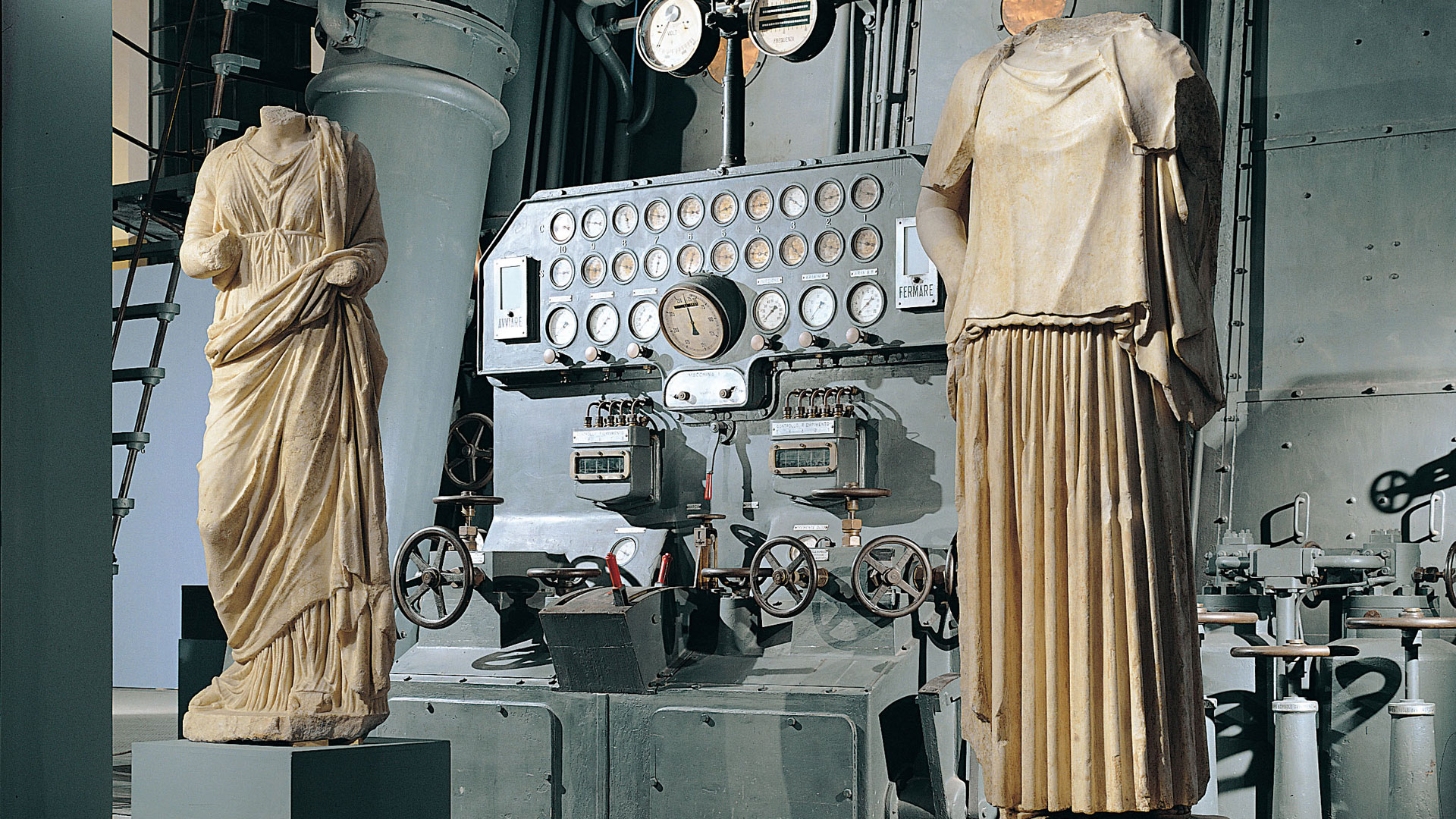
2. Markets of Trajan
In the great archaeological area of the Imperial Forums is an important complex of buildings that exemplifies the great design and architectural and engineering mastery of the Romans. Built on several levels, with a peculiar exedra shape and with innovative techniques in the construction by going to the slopes of the Quirinal Hill exploiting and playing with raised planes, unevenness and spaces, the Markets of Trajan constitute a unicum and at the same time a summa of their ability in this field. Precisely for this reason, in 2007 it was decided to open in these spaces the Museum of the Imperial Forums: a museum of Roman architecture that makes people discover the ways of building in antiquity with placement of exhibits in full-size reconstructions in order to appreciate the decorative and symbolic apparatus of the structures in their original context. This is also done with the help of multimedia forms of visitation that fully render the complexity of the Roman building site. In the heart of the city of Rome, in what was intended to be a set of monumental squares that were built over the course of a century and a half, Trajan’s Markets were a place of ancillary services and activities to Trajan’s Forum such as warehouses, stores, and administrative offices, which over the centuries evolved urbanistically and architecturally fulfilling various functions and transforming as it went along.
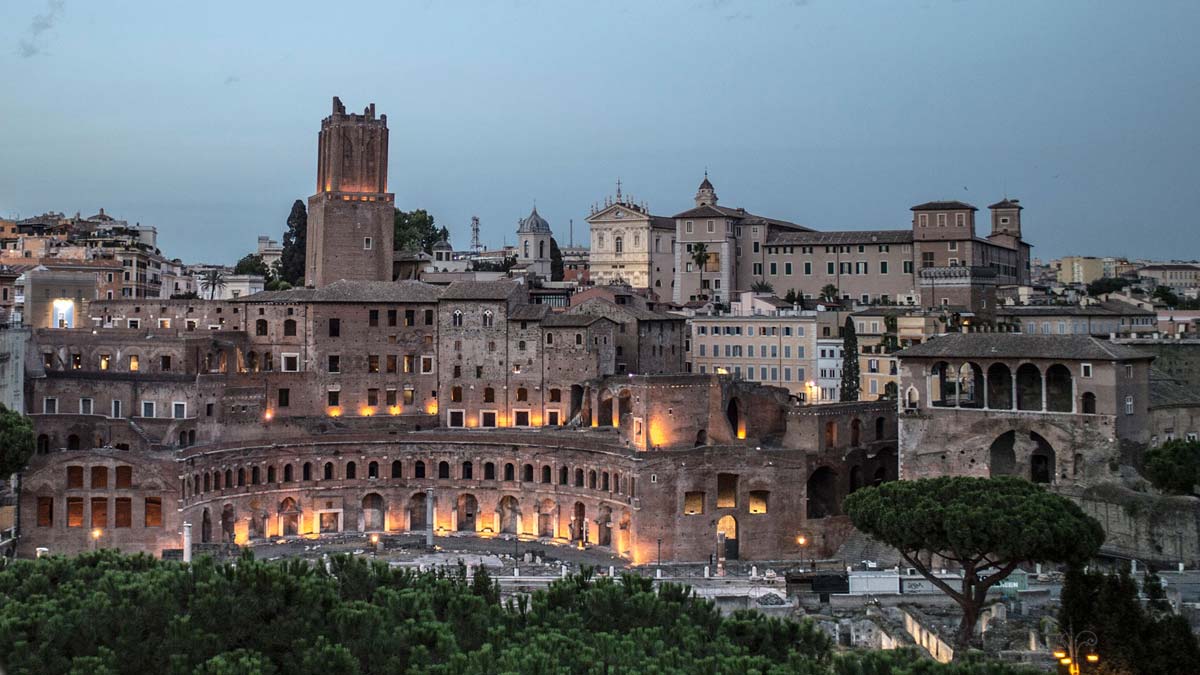
3. Sant’Andrea della Valle
With its dome soaring over the rooftops of Rome, the second tallest and widest in the city after St. Peter’s, the basilica of Sant’Andrea della Valle is a rich custodian of great works of art spanning multiple centuries of history, but it is the Baroque style that has its splendor here and takes over so much that it is among the greatest examples of it in the entire city. Consecrated in 1650 after sixty years of work by Giacomo Della Porta, Francesco Grimaldi, and Carlo Maderno at the behest of Duchess Costanza Piccolomini, it houses the funerary monuments of the family’s two popes, Pius II and Pius III, inside. To the monumental church in the following decade the facade was modified with the imposing realization of the one we see today by architect Carlo Rinaldi: all in travertine with a very jutting decorative apparatus that unleashes an intense play of light and shadow that emphasizes its features to the eyes of the passerby. An effect that before the creation of the square in front was greater due to the shorter viewing distance of the street. The Latin-cross church with a barrel-vaulted nave and eight interconnecting side chapels with a rectangular plan, followed by two circular vestibules, is richly decorated with Baroque frescoes and ornamentation. Not to be missed inside are Domenichino’s frescoes and Giovanni Lanfranco’s decoration of the dome with the Assumption of the Virgin , inspired by that which his countryman Correggio painted on the dome of Parma Cathedral.
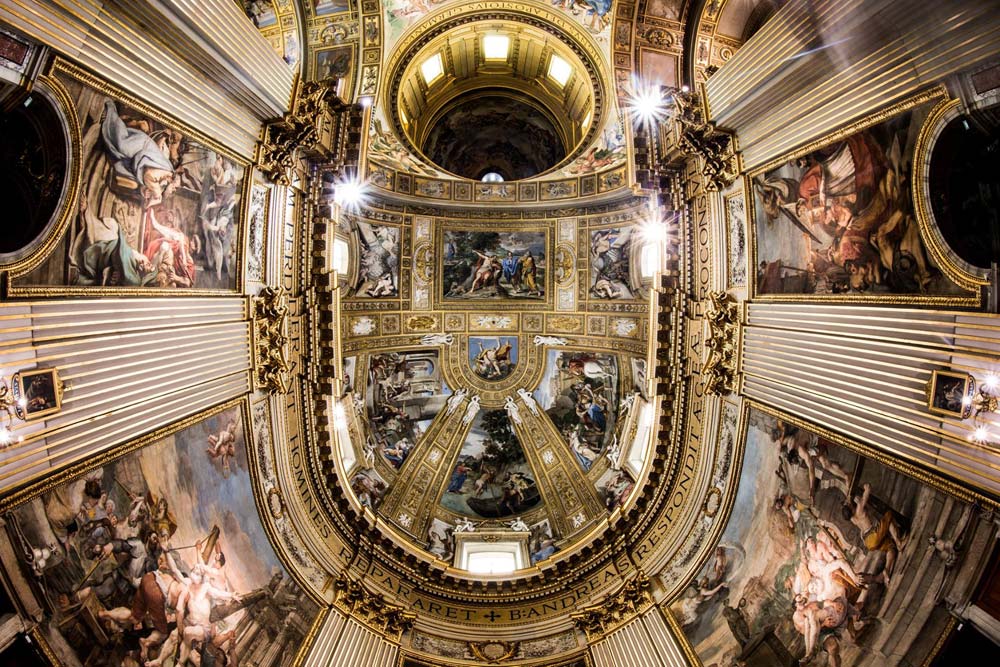
4. Saint Praxedes
Totally incorporated and embedded among other buildings, in Rome we find a splendid legacy of Byzantine gold mosaics in one, albeit hidden, of the city’s most revered churches in that inside it there would be a well, now covered by a porphyry disk in the middle of the cosmatesque-style floor, inside which is collected the blood of two thousand Christian martyrs that the Saint to whom the Basilica is dedicated had provided for burial (moved from the catacombs of Priscilla). This is the basilica of St. Praxedes, whose origins are lost in the early days of Christianity in that it is dedicated to the daughter of Senator Prudentius, the first Roman convert to St. Paul in the first century. Beneath the present church are the remains of Prudente’s family villa and the baptistery that Prassede had built on it, but the appearance of today is due to Pope Paschal I, who in the year 870 promoted the rebuilding of the building. The façade gives onto an uncovered courtyard, traceable to early Christian custom, on three sides of which it is surrounded by inhabited buildings, and in front of it an entrance hall opens into the building with a flight of steps leading to Via San Martino ai Monti, where a Romanesque barrel-vaulted porch opens. This entrance is closed and access is from Via Saint Praxedes. The Chapel of San Zenone is the most important Byzantine-style site in Rome. Also noteworthy are the triumphal arch mosaics in the apse that date from the 9th century.
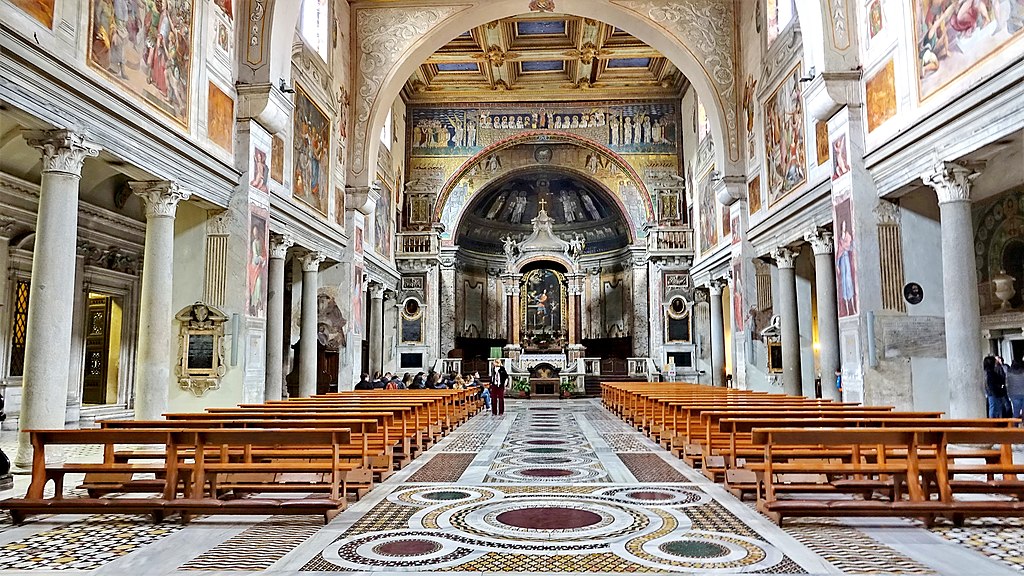
5. Santa Maria in Vallicella.
Three masterpieces by Rubens, a miraculous fresco, a painting by Guido Reni that has entered the iconography on Filippo Neri, and a marvelous chapel (precious marbles, semiprecious stones, and mother-of-pearl) dedicated to the saint who is popularly called “Goofy the Good” by the Romans for his work in assisting needy pilgrims who arrived in the capital of Christendom from all over. This and much more can be found inside the church of Santa Maria in Vallicella , which is inextricably linked to the figure of St. Philip Neri to whom it was entrusted by Pope Gregory XIII and which to this day is the headquarters of the Confraternity of Pilgrims and Convalescents, a work born of the “second Apostle of Rome.” The church was rebuilt with work beginning in 1575 with Pietro Bartolini of Città di Castello and finished in the first decade of the 17th century. The interior is richly decorated going against the wishes of the saint who when alive expressed a desire for simple and sober environments. On the high altar we have an altarpiece by Rubens, Angels in Veneration of the Virgin Mary that is commonly considered a masterpiece, flanked by two other canvases of his depicting saints. The three naves are vaulted, and on the dome and apse are frescoes by Pietro da Cortona. The miraculous fresco depicts a Madonna and Child who once struck by a stone gushed blood and became an object of devotion. So much so that it became the protagonist of a second miracle when, tradition tells us, during the celebration of a Mass a part of the roof collapsed and was supported by the hand of the Mother of the Church without hitting the faithful below.
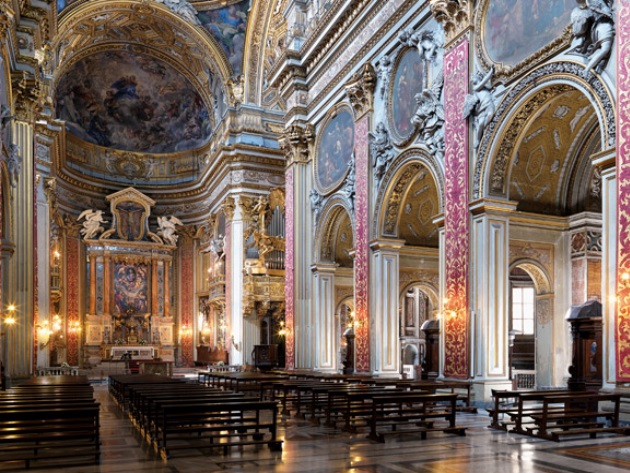
6. Santo Stefano al Celio
Santo Stefano al Celio is the first circular church in Rome, erected in early Christian times in honor of the first martyr of Christianity. Tucked between walls and a garden, it is entered through a five-arched portico postern. Once inside one sees the altar in the center, surrounded by a row of 22 Ionic columns arranged in a circumference with a diameter of 22 meters and as high as 22 meters.The second ring is formed by 36 columns and eight T-shaped pillars from which the walls that divided the third ring into as many areas that became chapels started. Four of them deeper than the other four alternating formed the Greek cross plan also given by the interplay of spaces and volumes consisting of the planes above the 4 arms of the church higher than the other 4 areas. On the interior perimeter walls there is a triumphal (and also bloody) epic of the martyrs with 34 frescoes attributed to Niccolò Circignani known as the Pomarancio and Matteo da Siena where the atrocious punishments inflicted on the martyrs are depicted in detail.
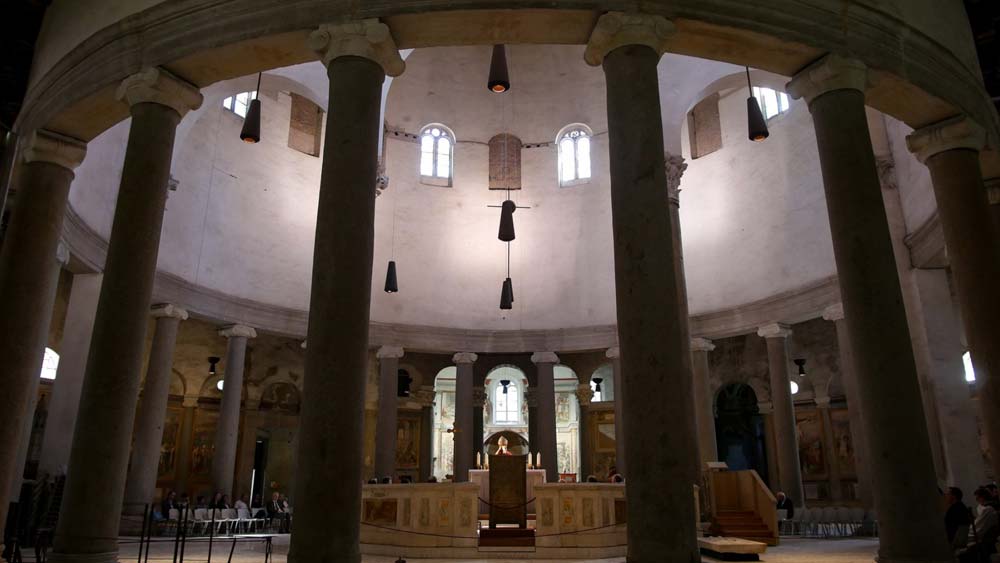
7. Coppedè Quarter.
In an imperial, renaissance and rationalist Rome also finds its place a neighborhood outside, deliberately, all the schemes, which leads the passerby to a modernity made up of contaminations of all the styles of the past: the Coppedè quarter. From the flair and genius of the architect-decorator who designed in the early twentieth century the agglomeration made up of 26 mansions and 17 cottages: the Florentine Gino Coppedè. Bas-reliefs, raised floors, balconies, projecting bodies, loggias, aedicules, towers, arches in an interplay of shapes and colors, stained glass windows and carved wood, sculptures and fountains, in his harmonious tangle of artistic and architectural styles influenced from Art Nouveau to Art Nouveau, from classical art models to Baroque Coppedè had envisioned this neighborhood as for consular headquarters and embassies, for the upper middle class. Palaces and cottages named after animals or fairies. Located in the Nomentano district, nearby is the famous Piper, from which the Beatles came out after a concert and jumped into the Fountain of Frogs.
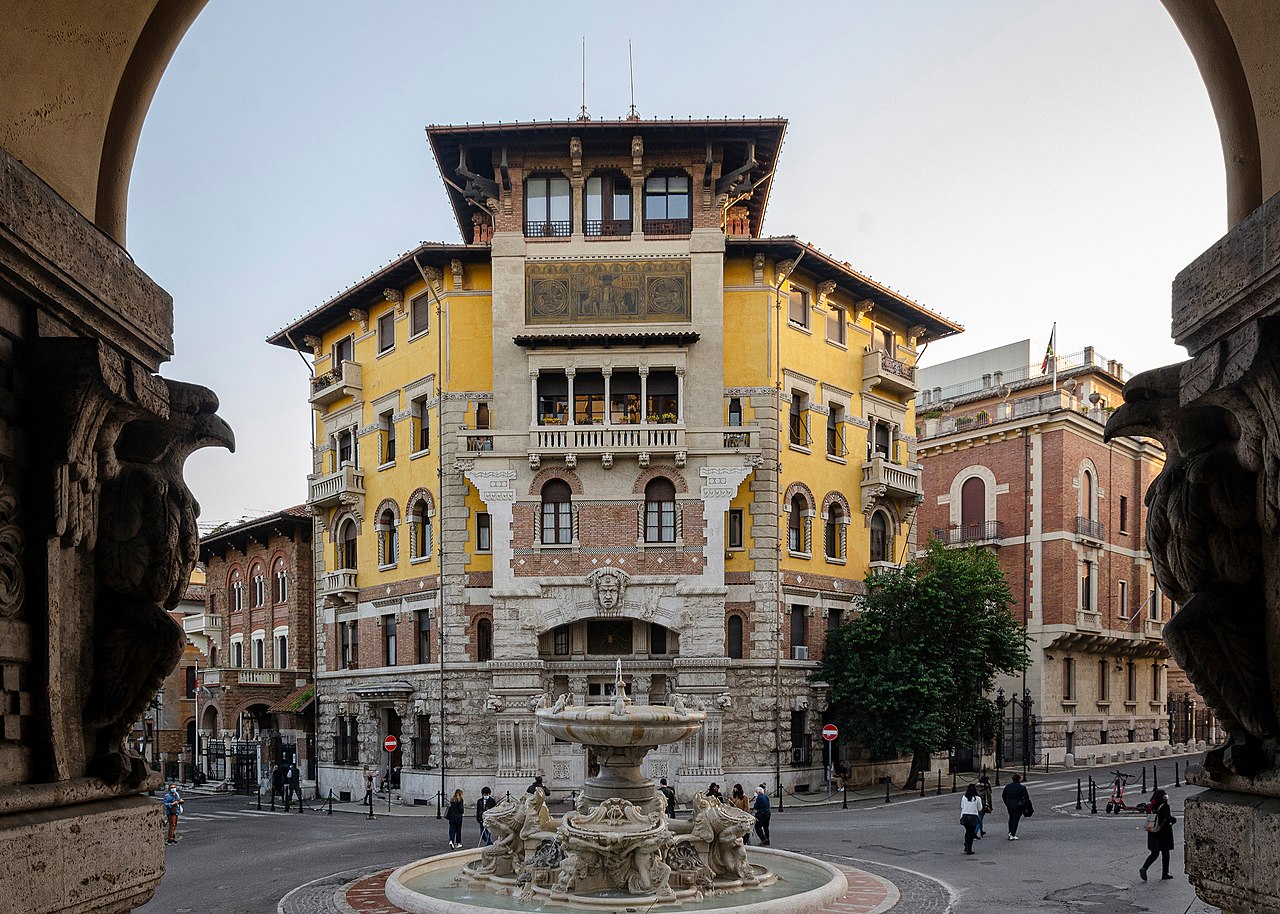
8. St. Mary of the Garden
Of the splendid St. Mary of the Garden Finestre sull’Arte spoke a few years ago with a detailed reportage : so we try here just to give some hints to entice a visit to this place off the classic tour operator ’s routes but which amply deserves to be known. We are in Trastevere and in the area where it now stands there were vegetable gardens, hence the name, and its construction in the late fifteenth century (which lasted over 70 years) was due to the Christian veneration of a miraculous image of the Madonna. The initial plan called for a Greek cross shape, which, however, Guidetto Guidetti, a pupil of Michelandelo, modified to a classical Latin cross with three naves. The glittering Baroque that can be admired inside has its climax in the oratory. It is the church of the. workers of Rome: in fact, it has popular origins and was built by their ancient guilds, the “trade associations” of the past.
9. The Casina delle Civette
The opulent Villa Torlonia with its park and buildings is now open to the public after restoration and redevelopment by the City of Rome in the 1970s, which in its work of enhancement made the Casina delle Civette the home of a museum dedicated to artistic glassmaking. An almost natural vocation given the splendid and unique stained glass windows that can be admired here. What we see today is a bizarre little building, with sloping roofs so steep as to be like those of the farthest Nordic countries while being in hot Rome, with unusual shapes and daring juxtapositions, in which the use of glass stands out above all else with uniquely designed and colored windows, the works of great artists who took turns for 15 years at the beginning of the 20th century: Cesare Picchiarini on designs by Duilio Cambellotti, Umberto Bottazzi and Paolo Paschetto. The original design of the Casina delle Civette was by Giuseppe Jappelli in 1840, which was followed by transformations in the 1920s by Vincenzo Fasolo with an Art Nouveau layout, and at the behest of Prince Giovanni Torlonia we owe the eclectic decorations with marble, stucco, majolica, wrought iron and precisely the famous stained glass windows. The museum has gathered a collection that enriches its contents and makes it unique.
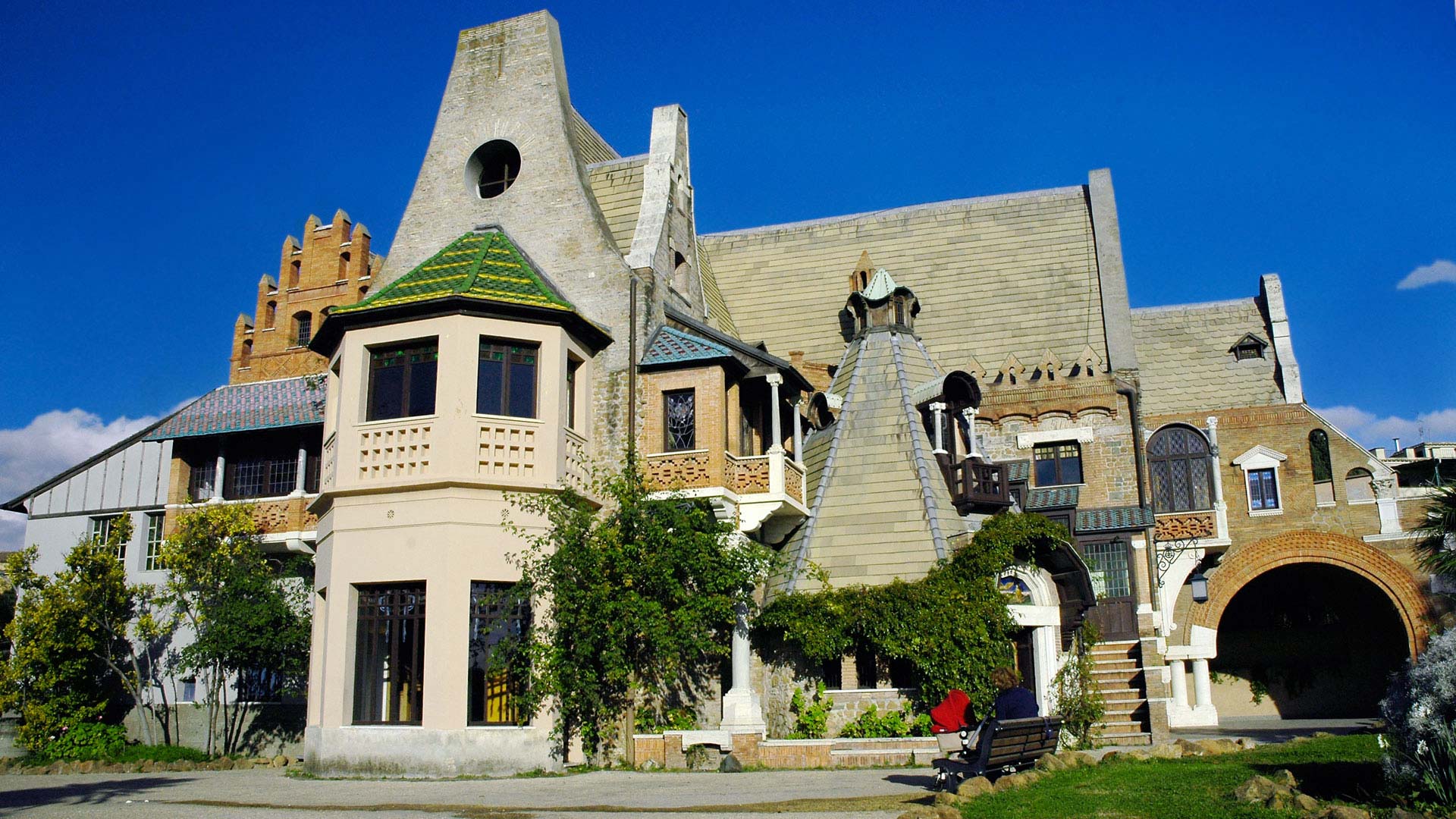
10. Little London.
In Rome it can also happen to find yourself in a street with an all-London flavor, with the classic two-story terraced houses one attached to the other but all different colors, with the wooden front door and the three steps descending to the street through the wrought-iron gate. That’s what happens at Bernardo Celentano Street, a 200-meter pedestrian walkway connecting Via Flaminia to Via Vignola with 13 cottages on each side. We are outside the center and the idea of pulling up British style houses was, by architect Quadrio Pirani, by the Anglo-Italian mayor Ernesto Nathan around 1910 when, with the drafting of the new Regulatory Plan, he wanted to try with urban and architectural experiments to make Rome a capital city with a European breath. Thus emerges an extemporaneous and out-of-context corner of the city that like other situations make this city rich and varied.
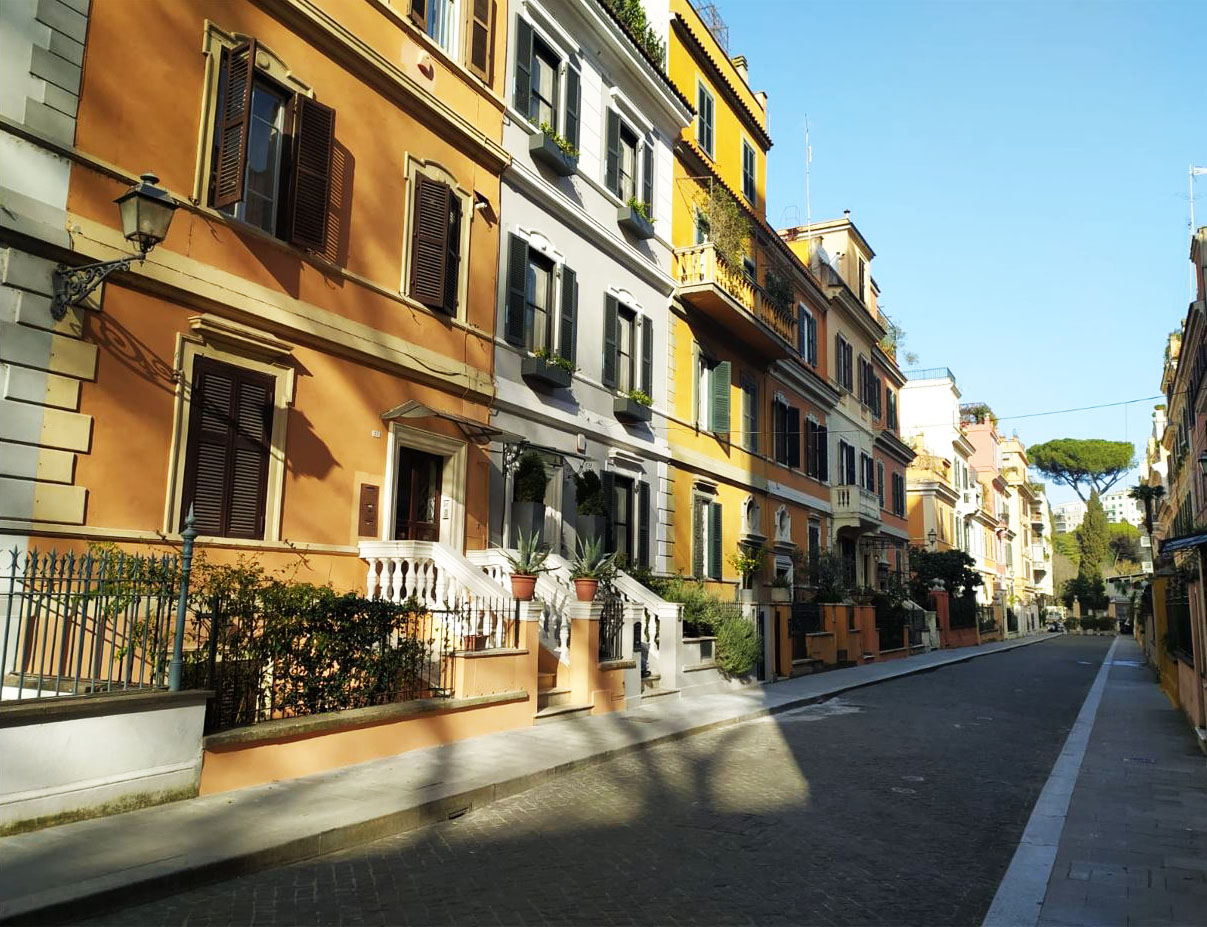
Warning: the translation into English of the original Italian article was created using automatic tools. We undertake to review all articles, but we do not guarantee the total absence of inaccuracies in the translation due to the program. You can find the original by clicking on the ITA button. If you find any mistake, please contact us .

Most read of the month


IMAGES
VIDEO
COMMENTS
In conclusion, mass tourism in Rome is a double-edged sword. On one hand, it generates revenue and creates jobs, but on the other, it leaves a trail of destruction in its wake. The high cost of living, gentrification of historic neighborhoods, and strain on the city's infrastructure are just some of the negative impacts of mass tourism.
A cross Europe, historic cities are buckling. Mass tourism, encouraged by cash-hungry councils after the 2008 crash and fuelled by the explosion of cheap flights and online room rentals, has ...
Italy's battle against mass tourism. Jonas Martiny. 08/09/2023. As Italy prepares to welcome a record number of tourists in 2023, cities and regions such as Venice and Sardinia are introducing ...
Italy's Battle with Problem Tourists. By: Wanted in Rome. Date: 24 Sep, 2020. Italy wants its foreign tourists back but not at the expense of damage to its precious cultural heritage. This summer's international headlines about tourists damaging Italy's sites and monuments weren't supposed to be like this. Just a few months ago there was much ...
The behaviour of some tourists is clearly a problem. But Italy has long depended on mass tourism, with the sector contributing €237.8 billion to the economy in 2019 - 13 per cent of its GDP. Put another way, that year there were 13 million overnight stays in Venice, 15.8 million in Florence and nearly 31 million in Rome.
When my family and I moved to Italy from Toronto 16 years ago, Rome was certainly touristy but there was no 24/7/365 deluge of visitors in every corner of the centre, and no Airbnbs.
Rome is cracking down on "gladiators" and street drinking in an attempt to keep the excesses of tourism in check. The clampdown comes amid a global travel boom that has resulted in popular destinations groaning under the strain of hordes of tourists. ... The year-round mass tourism generates income for Kinderdijk, but the village's ...
The pandemic is changing travel in Italy, though its full effects will take time to set in. The Easter holidays 'testing ground' has proven that mass tourism has returned to Italy's most popular cities like Venice, Florence, and Rome, though visitors for now are mainly Italians or Europeans. Cities and regions have drawn up post-Covid plans ...
The Italian capital's many historical and cultural attractions make it a veritable tourist magnet — in 2019, Rome recorded some 26 million overnight stays. ... many are fed up with mass tourism ...
In Rome 2023 was a record year for tourism, with visitor numbers eclipsing 2019. A person working for a luxury hotel said there was a renewed sense among its guests of "wanting to live life to ...
Yes, yes, absolutely yes. Here are 6 easy steps to enjoy a less crowded Italy and travel more sustainably. 1. Use e-bikes, e-scooters, and e-boats wherever possible. Rome and other Italian cities have started using electric transport, and all you need to ride is a smart phone to scan the QR code on the bike or scooter.
Rome is the 2nd most visited city in the EU, after Paris, and receives an average of 7-10 million tourists a year, which sometimes doubles on holy years. The Colosseum (4 million tourists) and the Vatican Museums (4.2 million tourists) are the 39th and 37th (respectively) most visited places in the world, according to a recent study. [1]
Rome CNN —. For all too brief a time, the Italian summer offered a glimmer of hope. After emerging from what was in early 2020, one of the world's harshest coronavirus lockdowns, Italy managed ...
As Florence braces for the return of mass tourism, Schmidt wants the Uffizi Diffusi project to take the heat off Florence, and is promising works by "household names" to help disperse the crowds.
Mass tourism is not a new phenomenon for Italy, but the number of visitors to the "Bel Paese" is increasing. Tourists are seen at St. Mark's Square in Venice, Italy, on April 15.
(In Rome, for instance, the historical center has lost about 20,000 residents.) But in Italy, and especially in certain areas, the main problem is that mass tourism has become the only source of ...
However, due to its popularity, Rome is now experiencing overtourism, damaging its landmarks and authenticity. Overtourism, or mass tourism, is a phenomenon (especially accentuated by social media) when popular places are visited by an excessive quantity of tourists, causing undesirable effects on the destination.
Overtourism is the antithesis to this, tourism is using the place and degrading it. Overtourism describes destinations where hosts or guests, locals or visitors, feel that there are too many visitors and that the quality of life in the area or the quality of the experience has deteriorated unacceptably. It is the opposite of Responsible Tourism ...
For more information about our initiatives in Italy to promote sustainable tourism and create further awareness about environmental and social implications of mass tourism, get in touch with the experts: [email protected]. Written by Jesse Andrews, Owner & President, August 2, 2017. Jesse Andrews owns 6 websites dedicated to ...
In this century, mass tourism privileged Rome-as-antiquity over Rome-as-religious-center: foreign tourists successfully co-opted the Eternal City, shifting the topos from future to past. Part three takes the tourist guidebook as the textual medium that perpetuates this retrospective orientation, and shows
Write to them at Via dell' Umiltá 30, 00187 Rome, call on + 06.6900.1821, or email them at [email protected] Book Your Tickets St. Peter's Basilica Dome Guided Tour
Mass tourism notably developed in Western societies since the 1950s. This was the result of a period of strong economic growth. Mass tourism was first seen in Western Europe, North America and Japan as these countries had strong economies and thus the general public were wealthier overall. Globalisation has also fuelled the mass tourism ...
Rome, 10 unusual places far from mass tourism: Warning: the translation into English of the original Italian article was created using automatic tools. We undertake to review all articles, but we do not guarantee the total absence of inaccuracies in the translation due to the program. You can find the original by clicking on the ITA button.